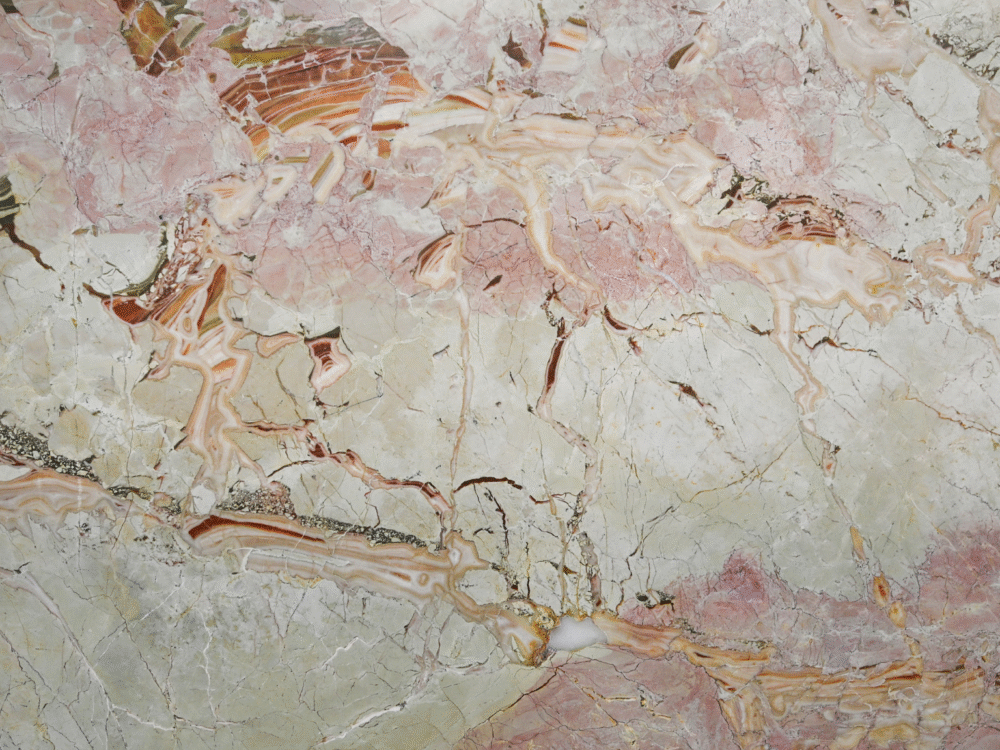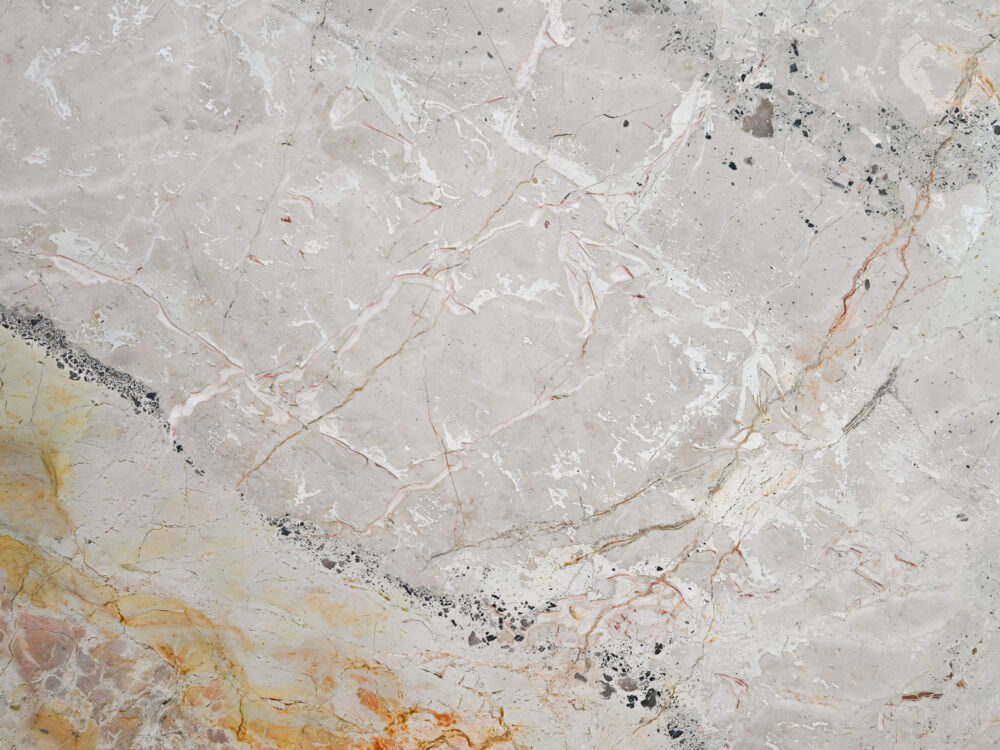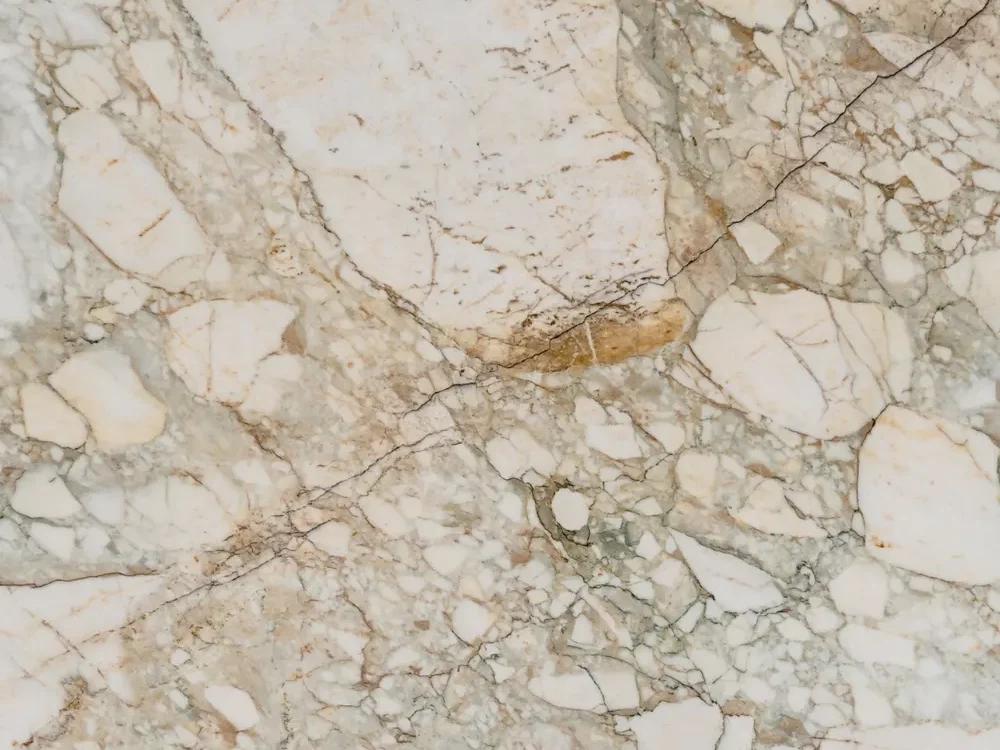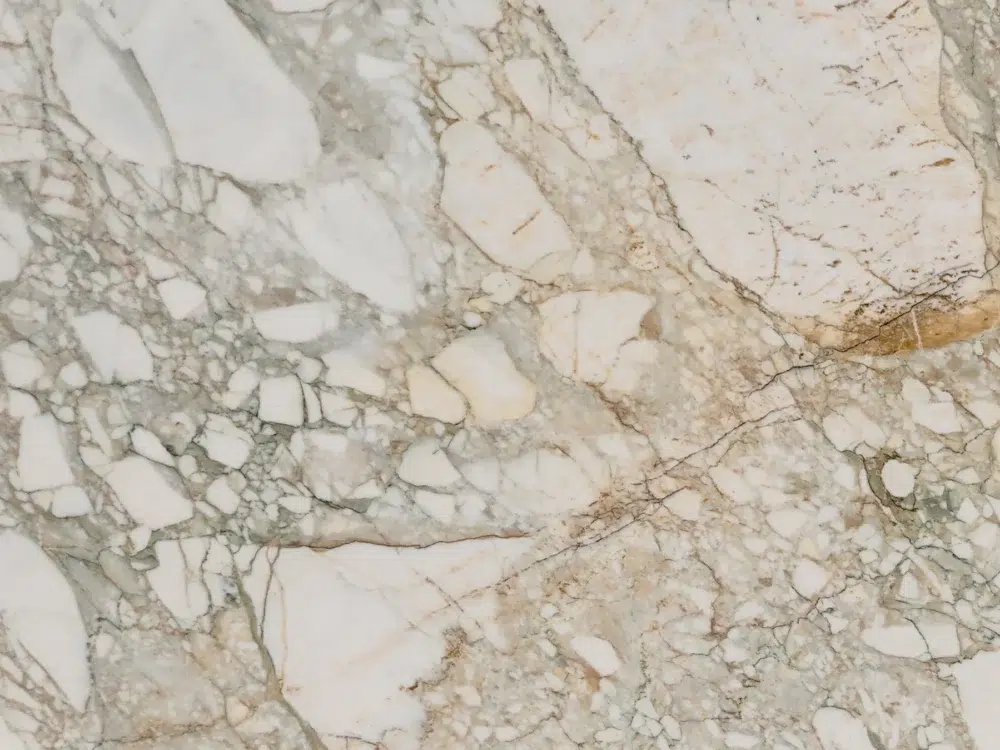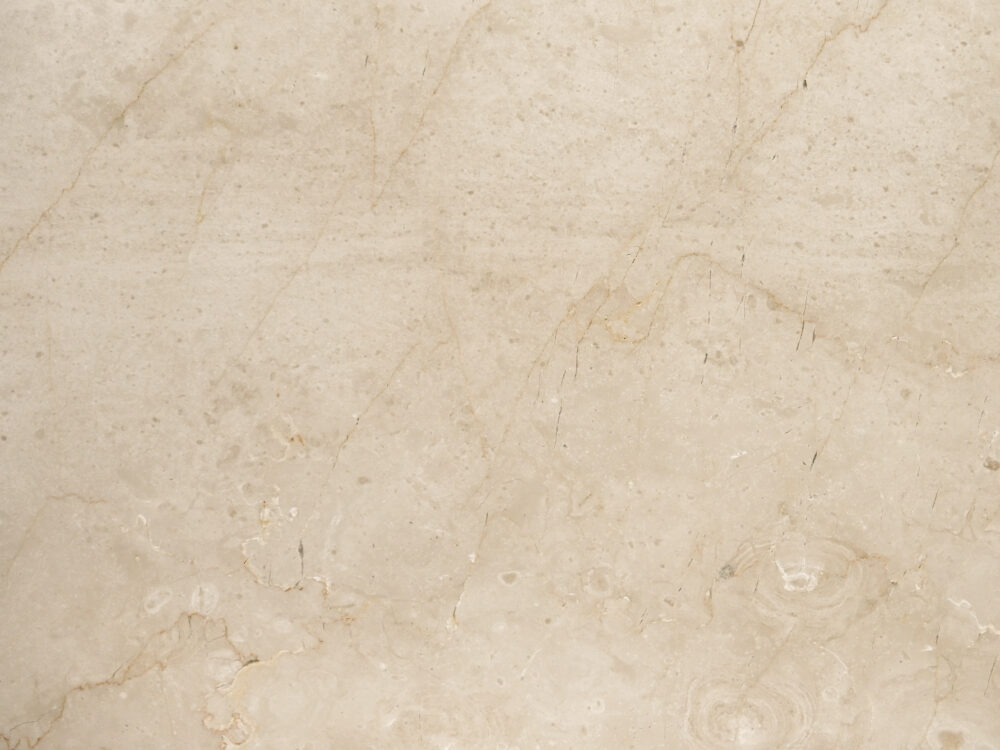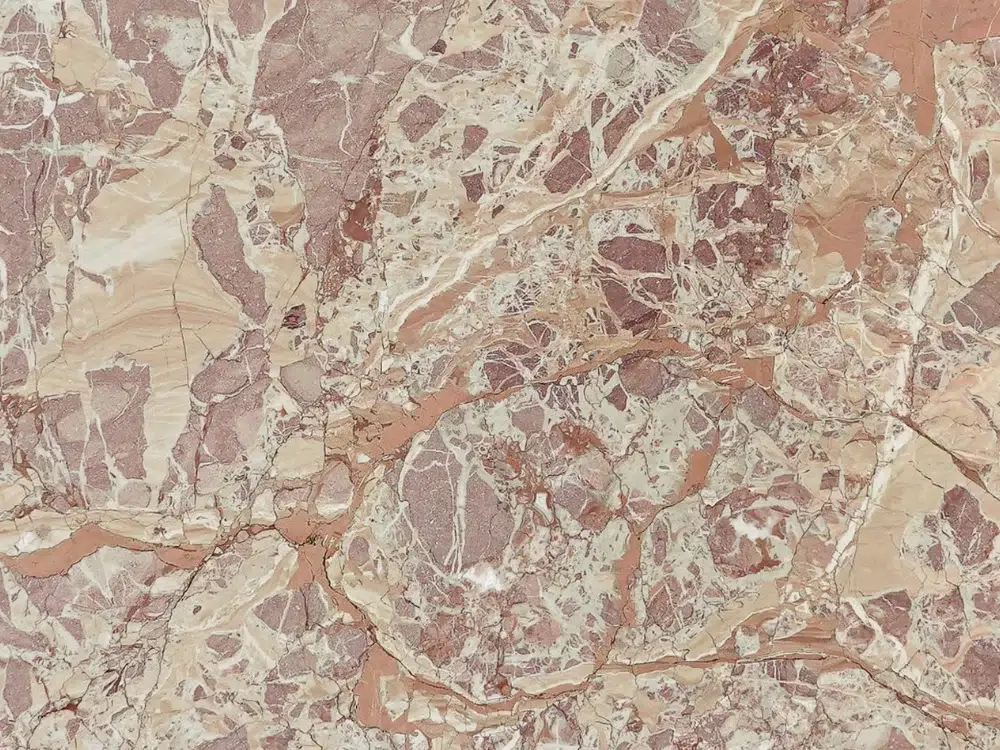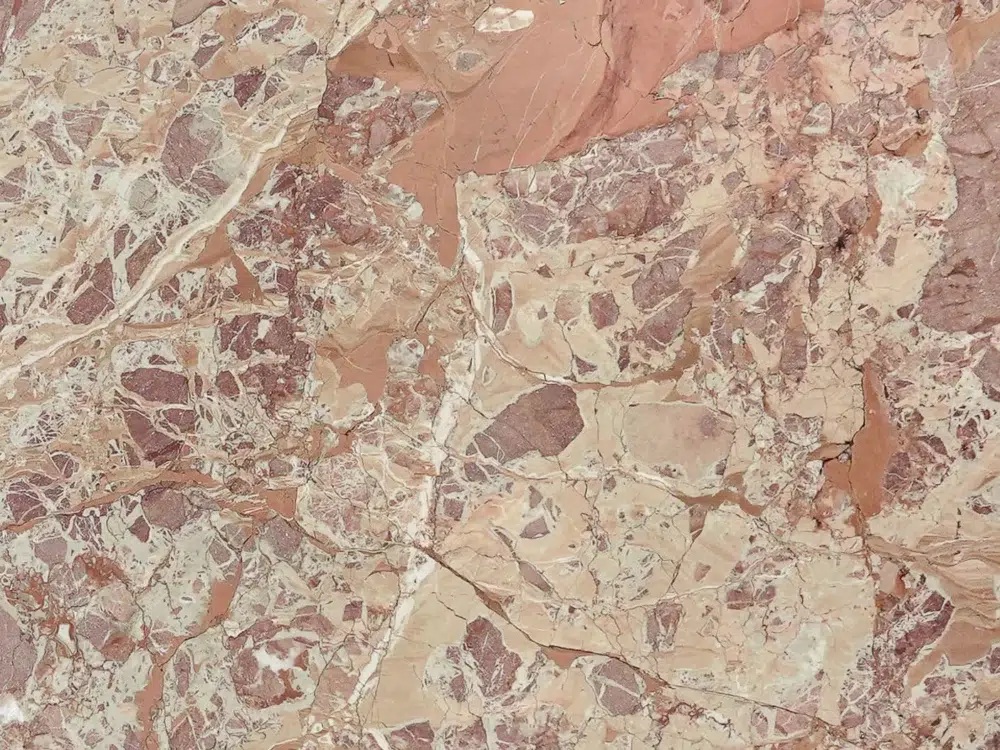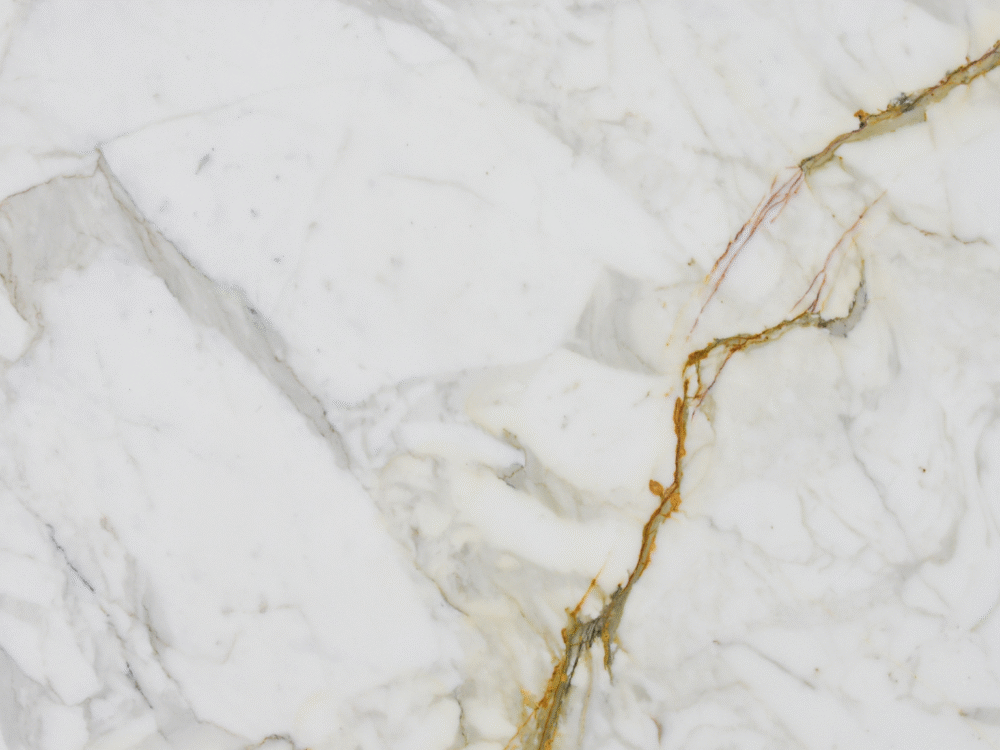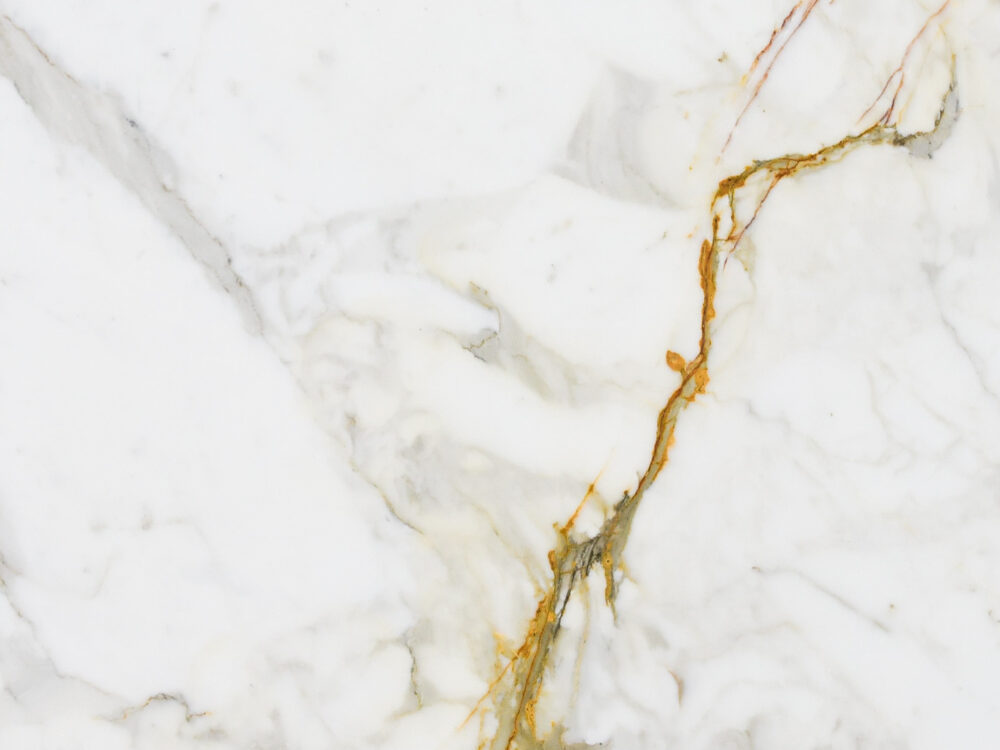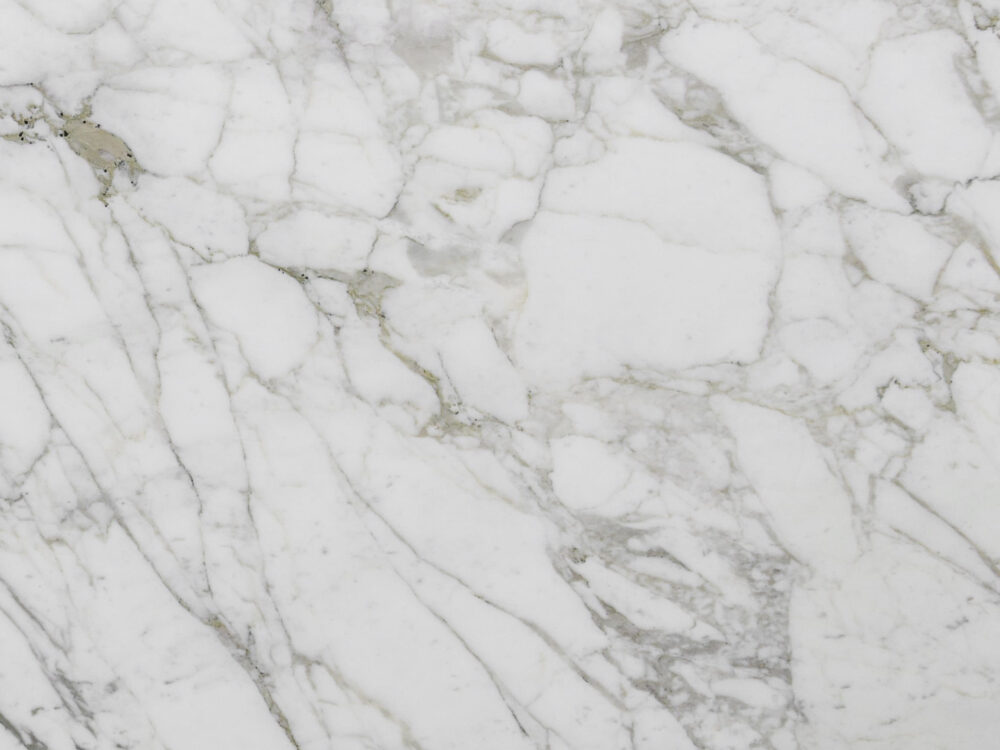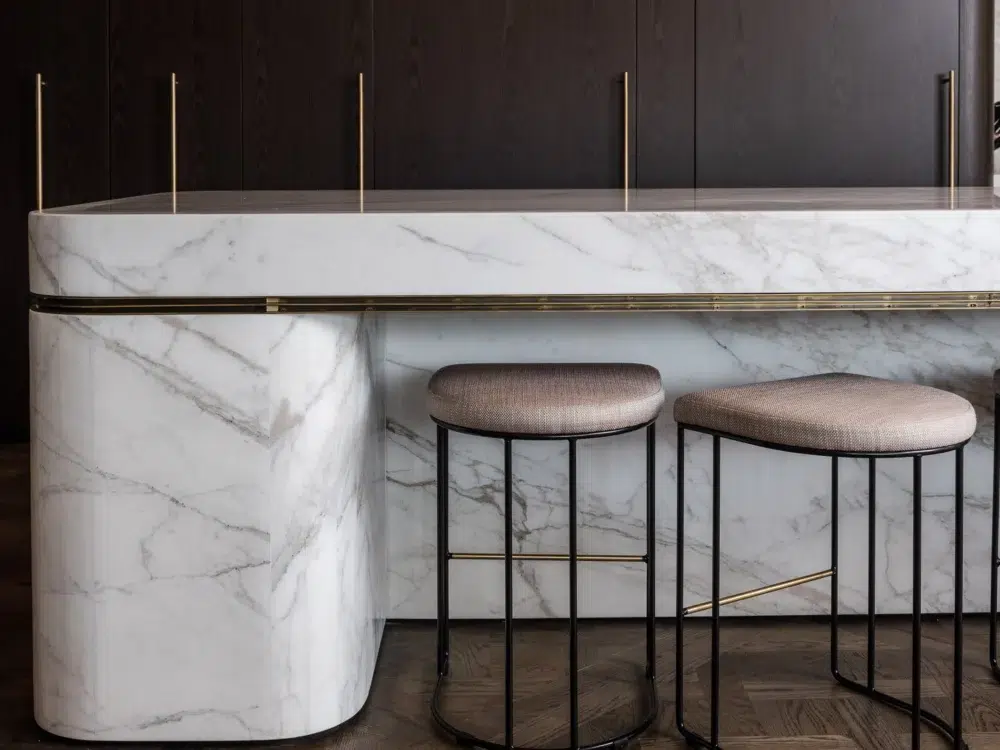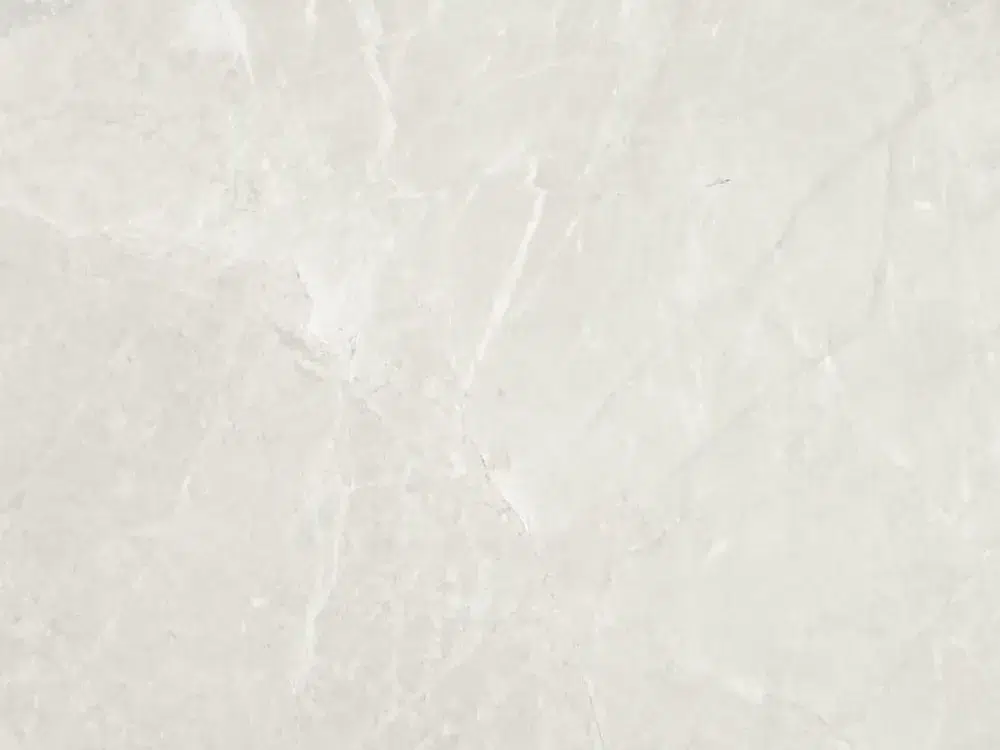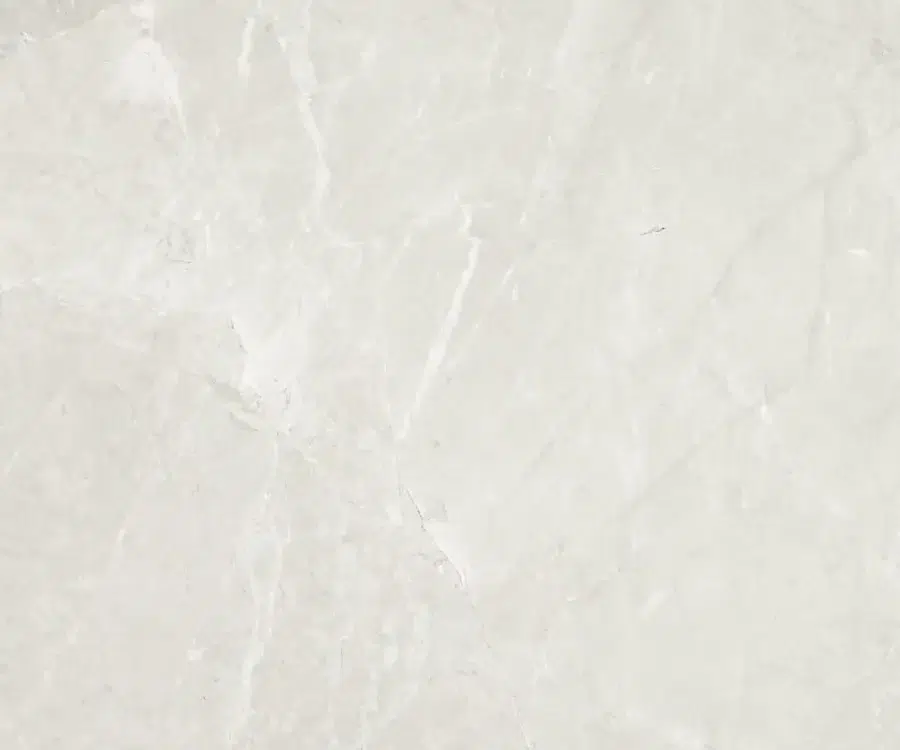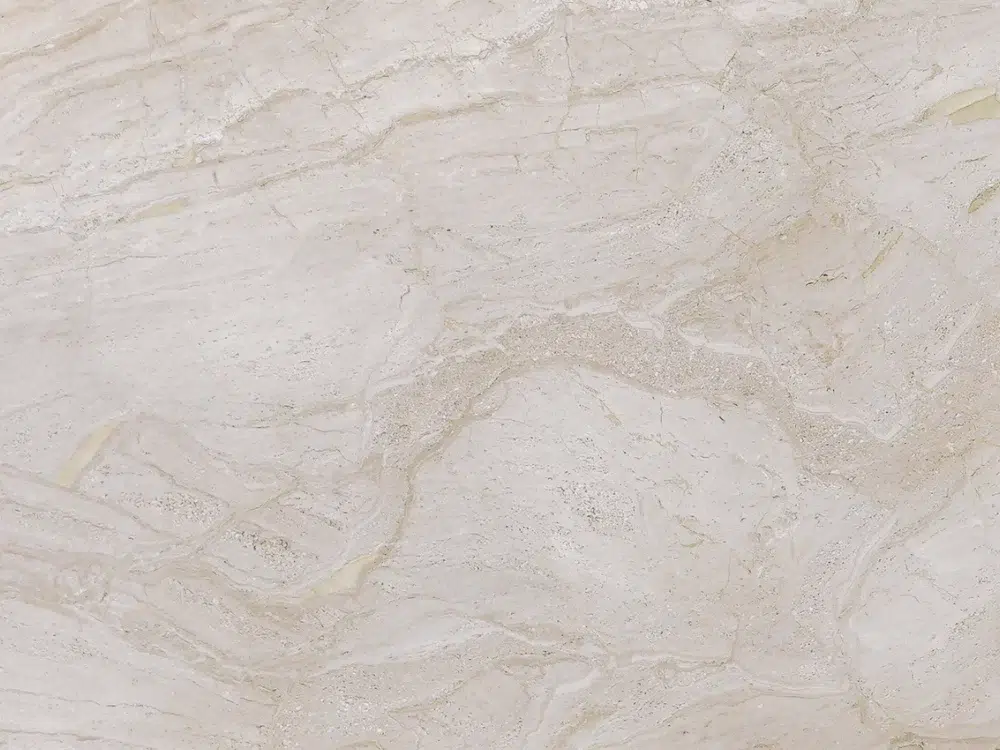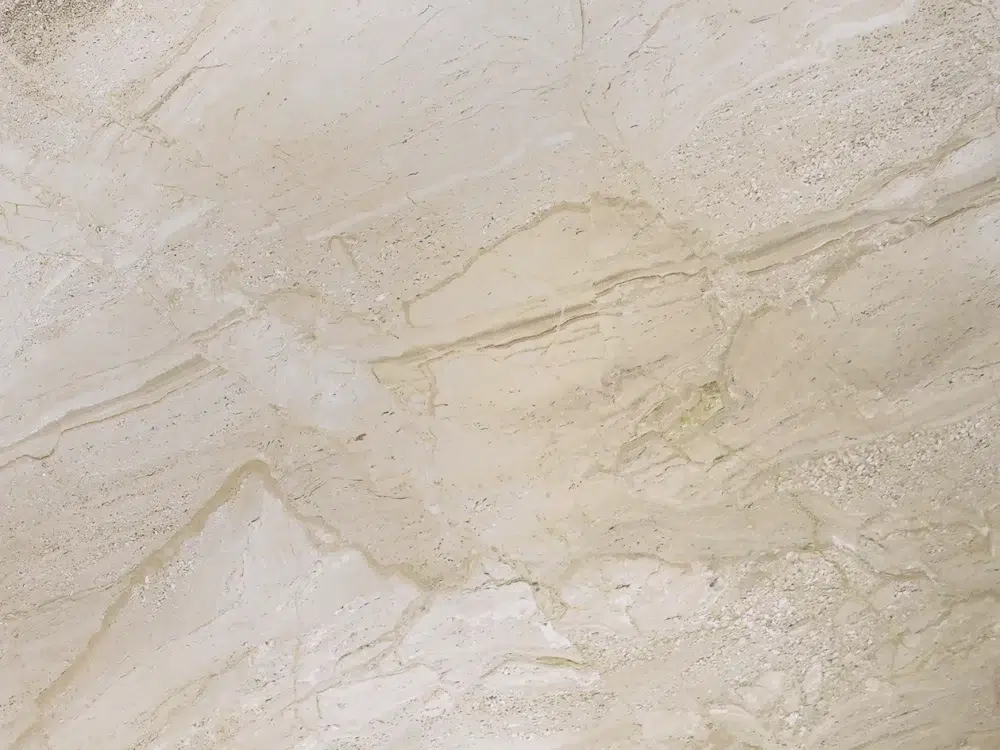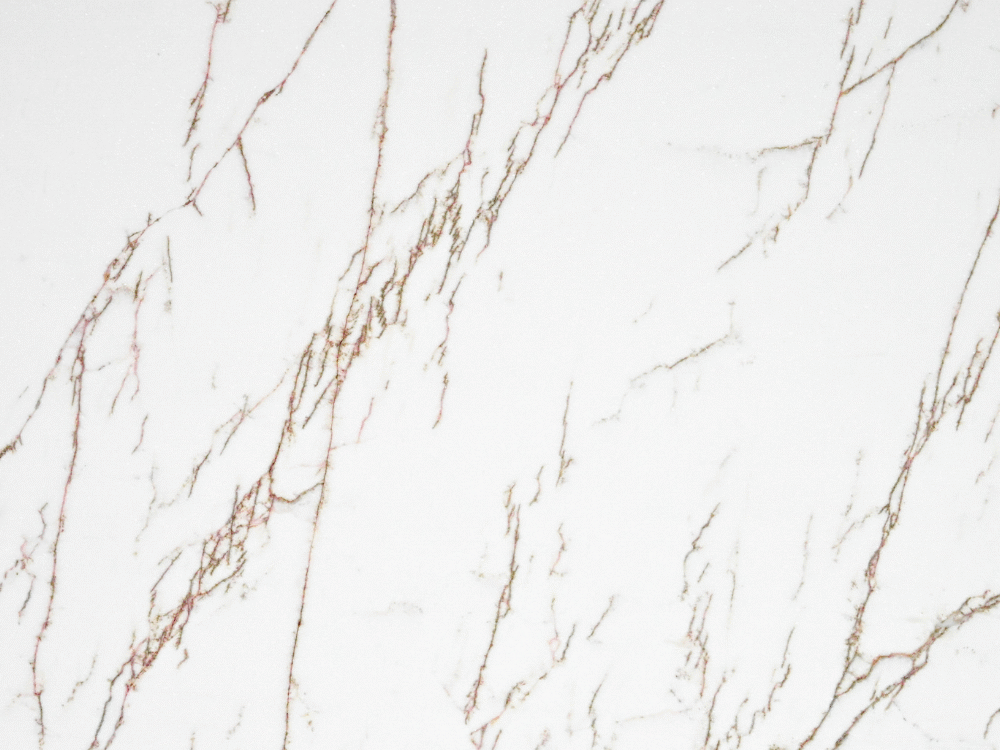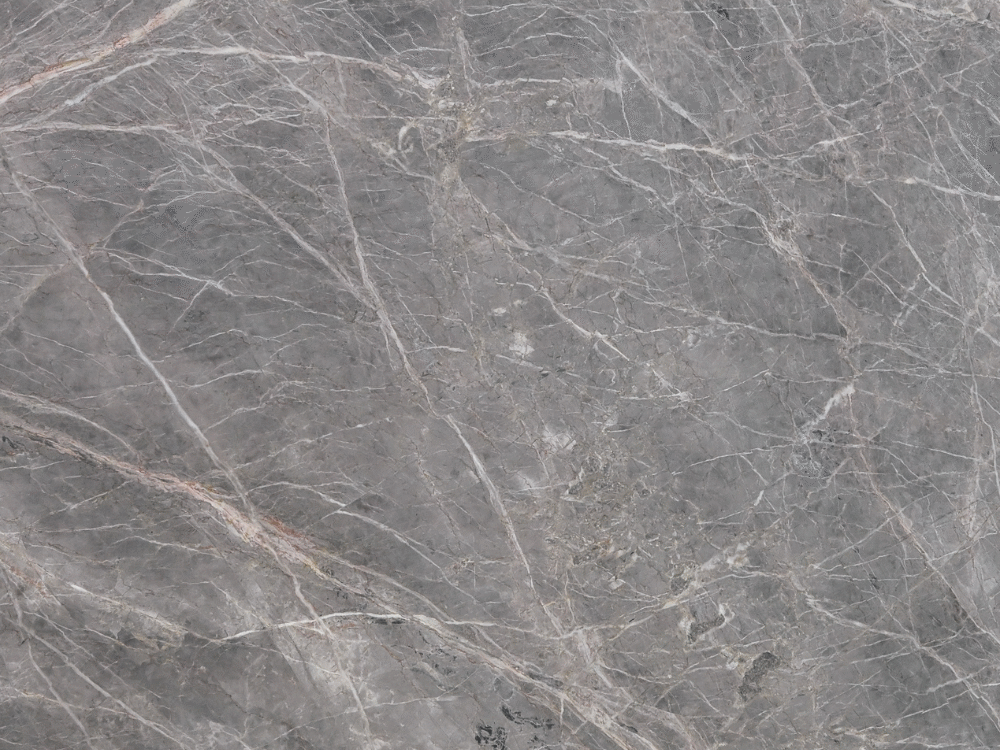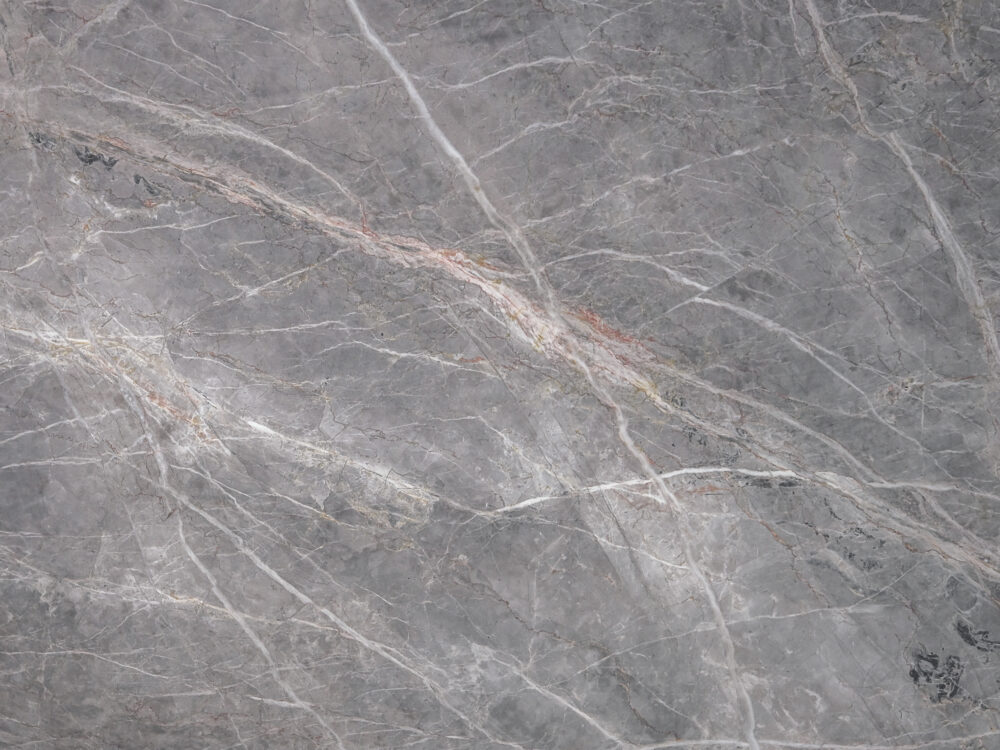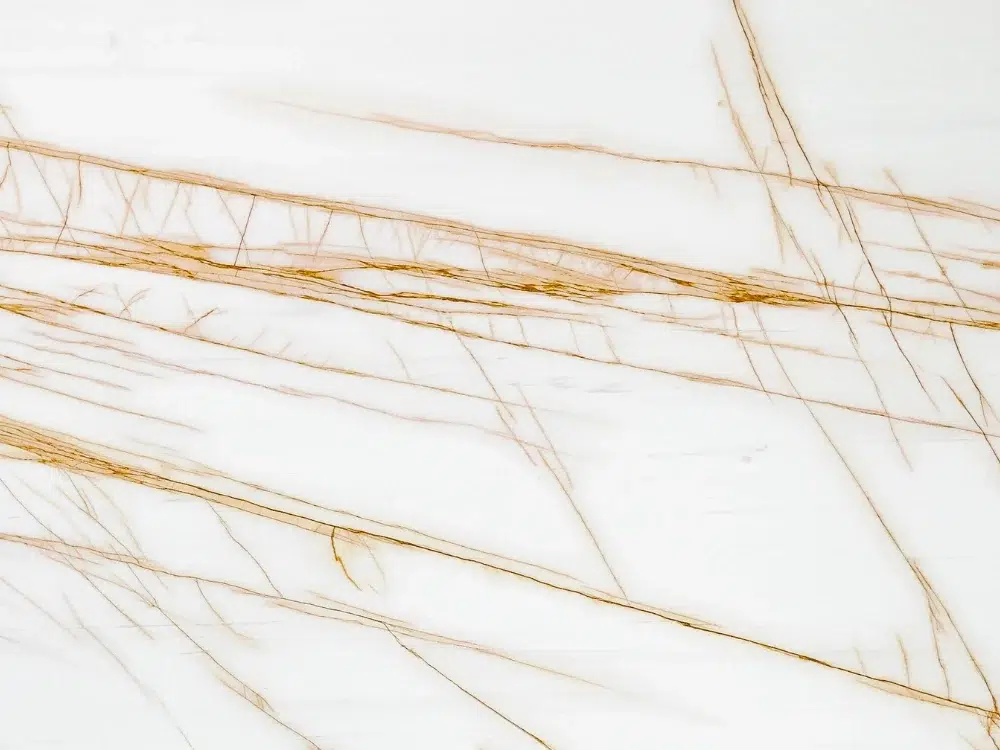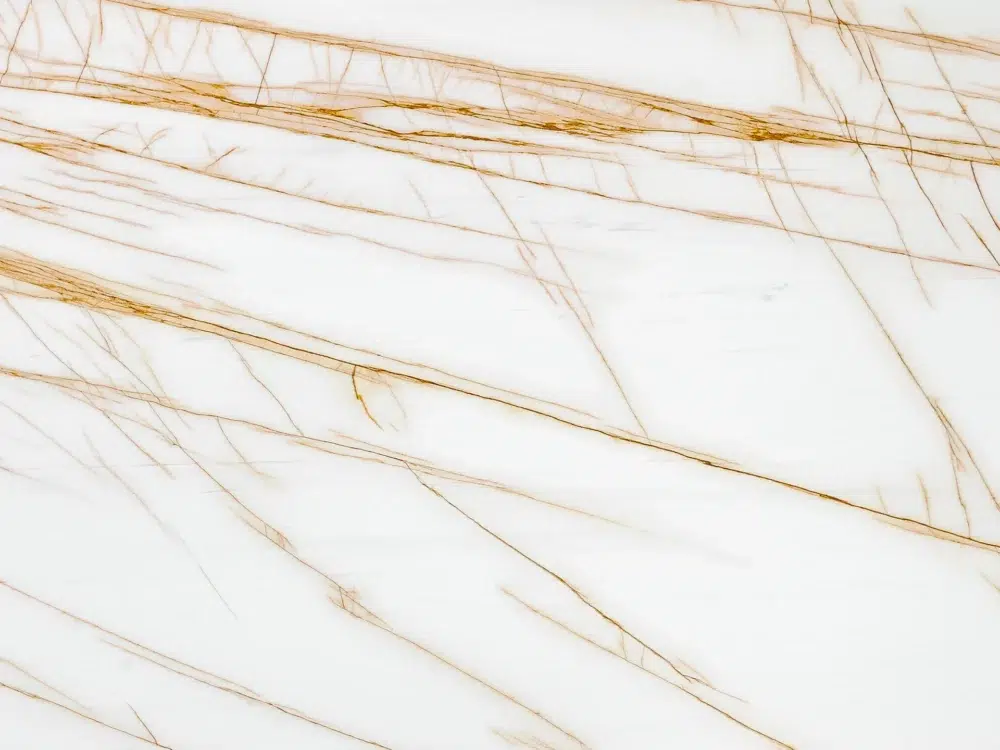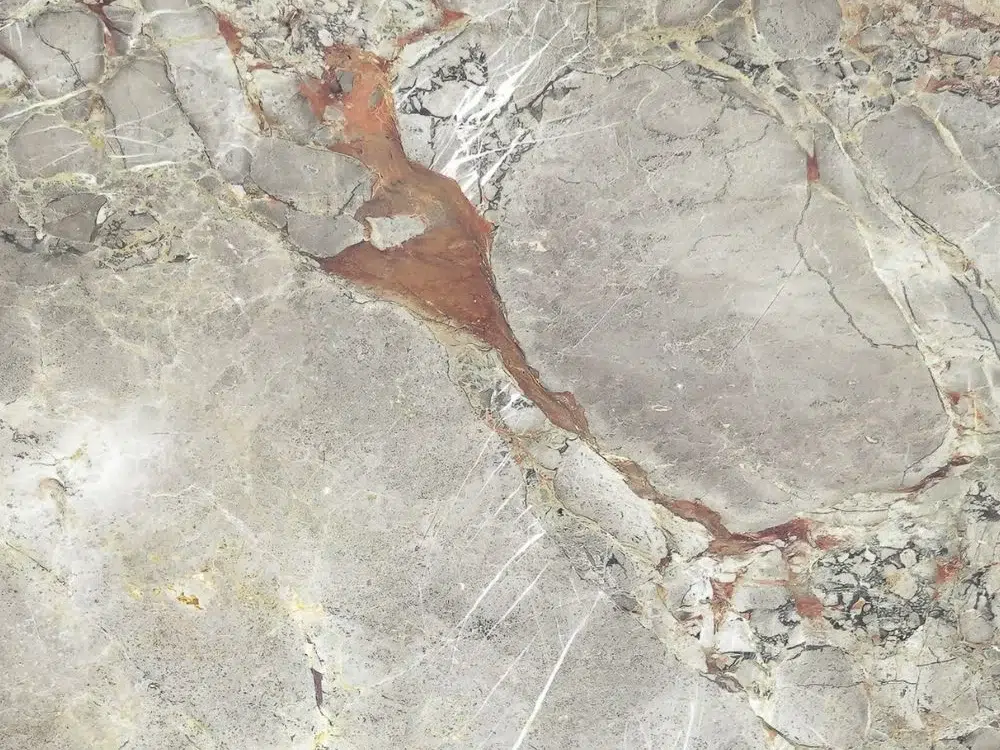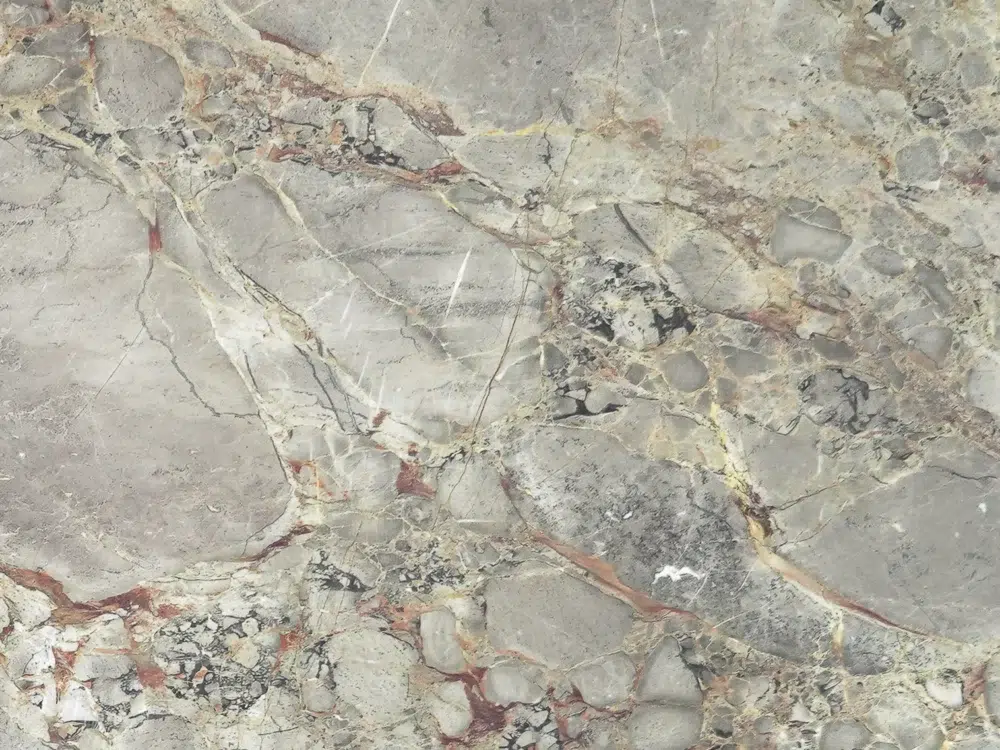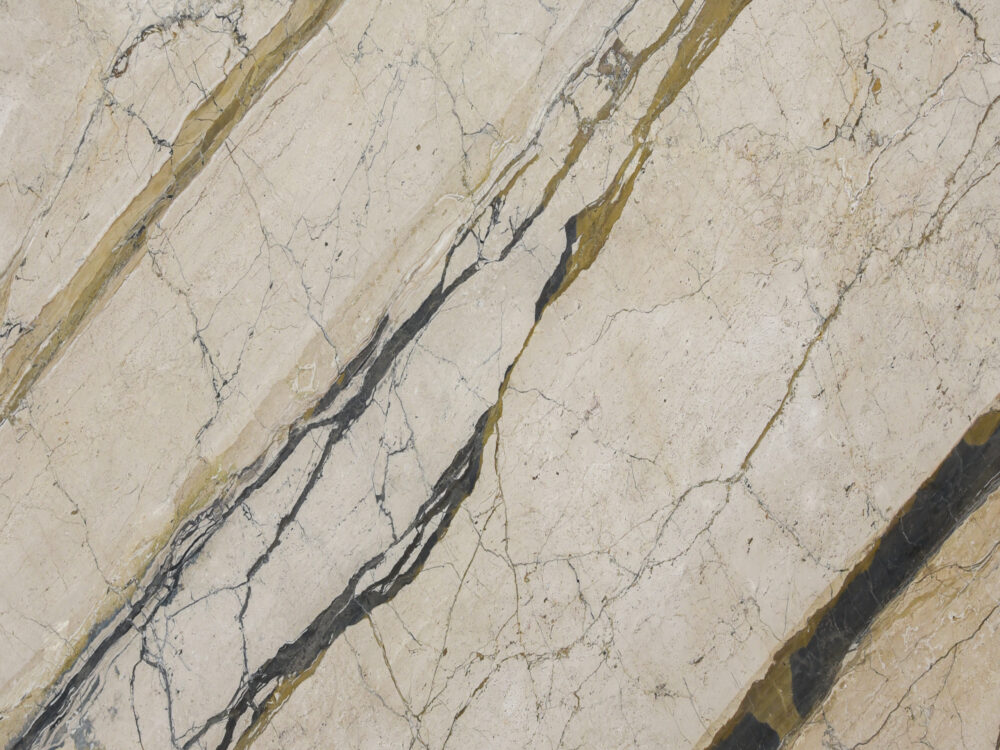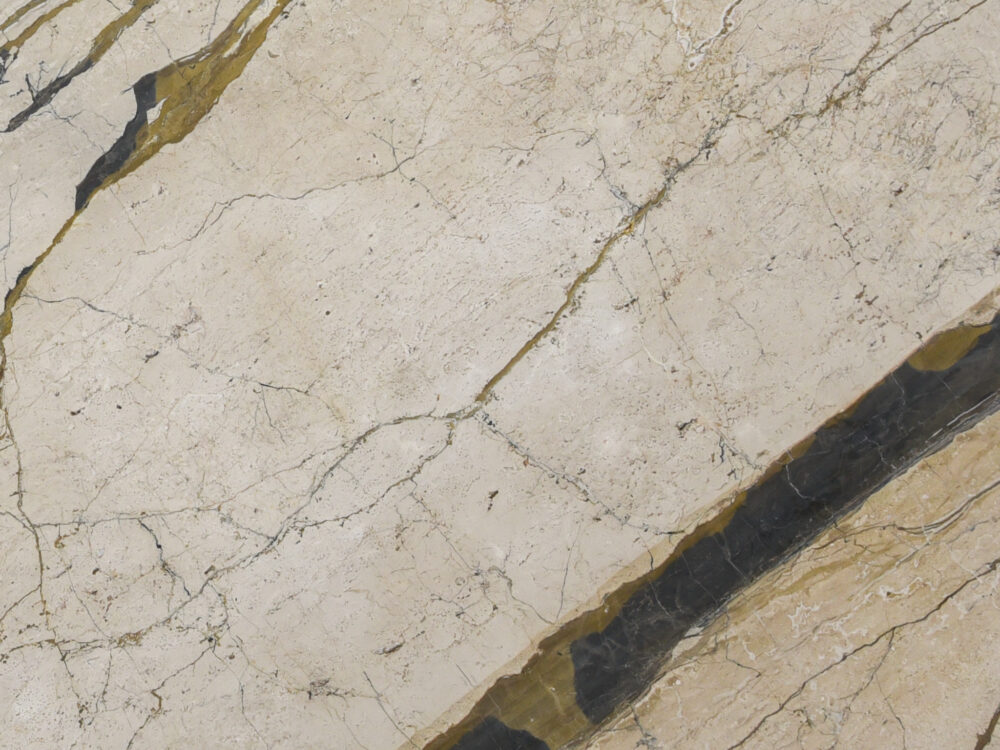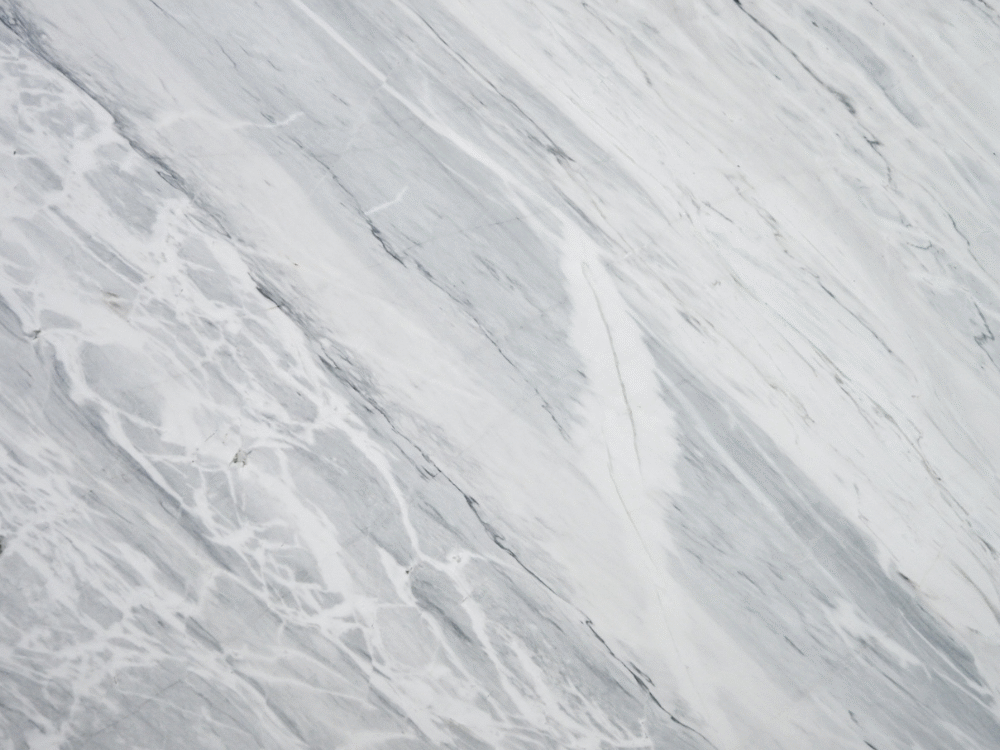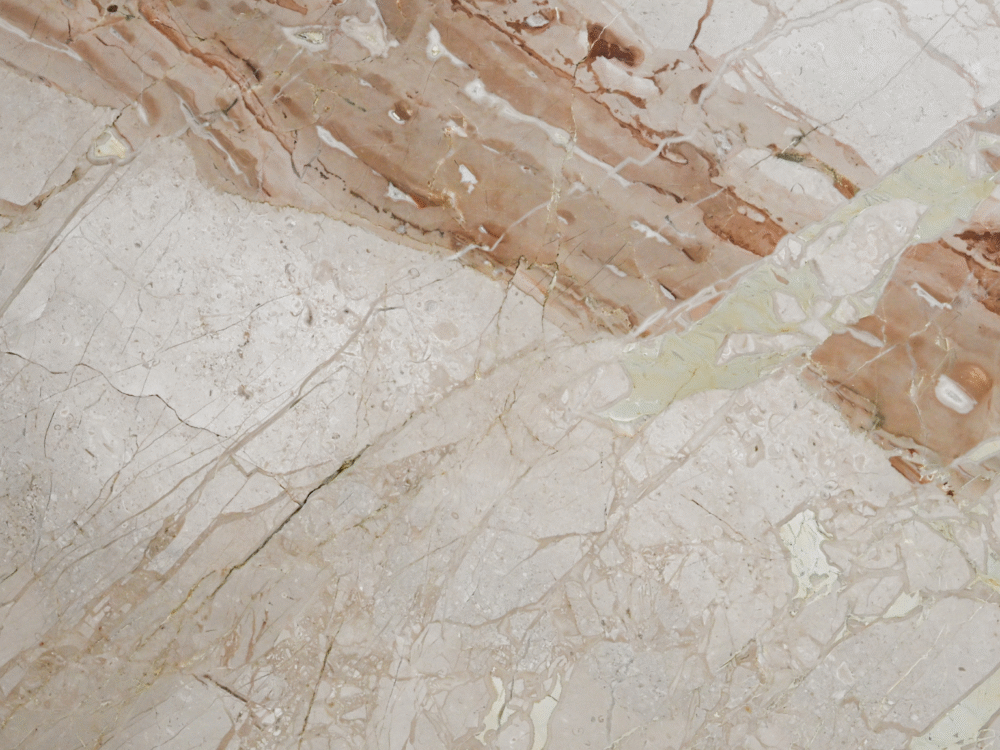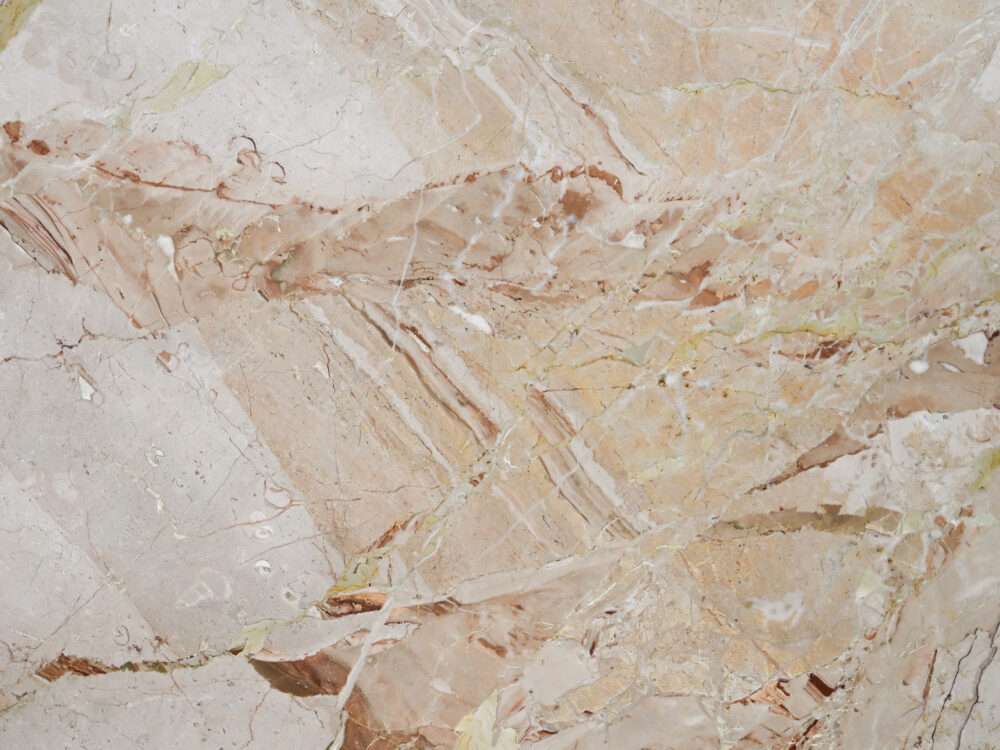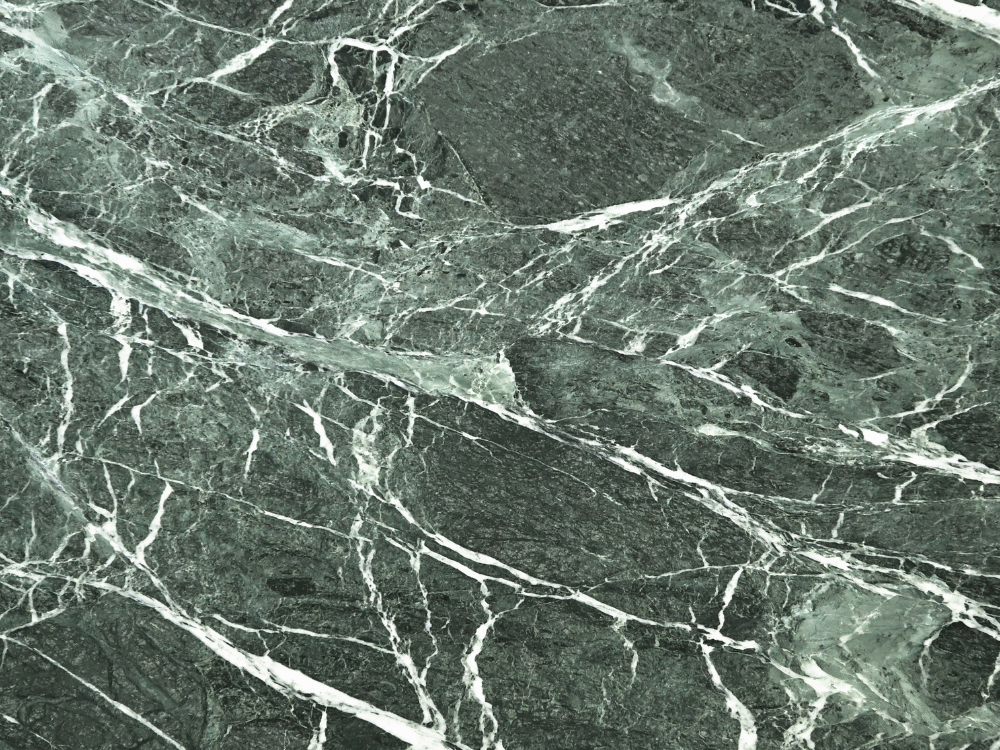-
Alessia Marble
Alessia Marble showcases a warm light salmon base, interwoven with brecciated segments in rich red and burgundy tones. Subtle pink salmon accents add depth and dimension, creating a visually dynamic surface with an inviting warmth. This marble’s organic composition and intricate patterning make it a striking choice for feature walls, statement countertops, or sophisticated flooring. Blending classic elegance with a bold, contemporary twist, Alessia Marble enhances interiors with a refined yet distinctive aesthetic.
-
Arabescato Corchia Marble
Arabescato Corchia is an exquisite Italian marble featuring dramatic black and grey veining with warm copper accents against a soft ivory background. The flowing veins create dynamic, organic patterns that make each slab a unique masterpiece of natural elegance.
What makes Arabescato Corchia special is its rich tonal depth. The interplay of dark veining and metallic copper highlights against the creamy ivory base creates movement and visual interest that draws the eye. It’s bold enough to make a statement yet refined enough to complement a range of design styles.
This versatile marble works beautifully in both traditional and contemporary interiors. Its arabesque patterning suits large format applications like kitchen islands and feature walls, while smaller pieces create stunning shower niches and vanity tops.
Best for: Kitchen benchtops, feature walls, bathroom vanities, flooring, fireplace surrounds,
Like all marble, Arabescato Corchia requires regular sealing and careful maintenance. Avoid acidic substances and wipe spills promptly.
Visit our Sydney or Newcastle showroom to see Arabescato Corchia slabs in person.
Sydney: 02 9817 0037 | Newcastle: 02 8321 0742
-
Arabescato Gold Marble
Arabescato Gold Marble is a stunning fusion of luxury and nature’s craftsmanship. Its pristine white canvas provides the perfect backdrop for unique veining that weaves together rich gold, soft grey, and warm copper tones — creating a harmonious blend of elegance and warmth.
The distinctive arabesque patterning flows organically across each slab, with the metallic gold and copper accents catching the light beautifully. This interplay of warm tones against the bright white background sets Arabescato Gold apart from cooler Italian marbles, making it ideal for spaces that call for sophistication with a touch of warmth.
This versatile marble suits both classic and contemporary interiors. The flowing veins create natural movement that works beautifully in large format applications while remaining refined enough for smaller features.
Like all marble, Arabescato Gold requires regular sealing (every 1-2 years) and prompt cleanup of acidic spills to maintain its timeless beauty.
Visit our Sydney or Newcastle showroom to see Arabescato Gold slabs in person.
-
Arabescato Vagli Marble
Arabescato Vagli is a refined Italian marble sourced from the picturesque quarries of Italy. Its sophisticated white background is accented by striking grey veins that flow organically across each slab — the signature characteristic of the Arabescato family.
What distinguishes Arabescato Vagli is its balanced elegance. The veining is bold enough to create visual interest without overwhelming a space, making it incredibly versatile for both residential and commercial interiors. It harmonises beautifully with contemporary minimalism and classic luxury alike.
The mesmerising arabesque patterns make this marble perfect for creating standout focal points. Whether used for a dramatic fireplace surround, a statement kitchen island, or elegant wall cladding, Arabescato Vagli elevates any application with timeless Italian sophistication.
Like all marble, Arabescato Vagli requires regular sealing (every 1-2 years) and prompt cleanup of acidic spills to maintain its refined beauty.
-
Arabescato Verde Marble
Arabescato Verde Marble showcases a white base with dramatic veining that weaves through the stone, accentuated by soft salmon pink tones. These warm accents bring a unique, inviting elegance to the surface, offering a fresh take on traditional marble. The stone’s dynamic veining and subtle colour palette make it a sophisticated choice for both modern and classic interiors. Perfect for statement countertops or striking feature walls, this marble introduces a refined warmth to any space.
-
Arctic White Marble
Arctic White Marble is a refined Greek marble that delivers premium elegance with understated sophistication. Its crystalline white background provides a bright, luminous base, while delicate dark grey veining adds just enough movement to create visual interest without overwhelming a space.
What makes Arctic White special is its balance — it’s luxurious without being flashy, distinctive without dominating. This makes it incredibly versatile for both contemporary and classic interiors where a clean, timeless aesthetic is desired.
The subtle patterning pairs effortlessly with a wide range of cabinetry colours, from warm timbers to sleek modern finishes. It brightens spaces naturally, making rooms feel larger and more open.
Origin: Greece
Colour Palette: Crystalline white, dark grey veining
Character: Subtle, refined, balanced
Best for: Kitchen benchtops, bathroom vanities, splashbacks, feature walls, internal wall cladding
Like all natural marble, Arctic White requires regular sealing (every 1-2 years) and prompt cleanup of acidic spills. With proper care, this enduring stone maintains its fresh, elegant appearance for decades.
-
Ariana Gold Marble
Ariana Gold Marble is a beautiful natural stone that combines a clean-looking white background with delicate grey veining. Its appearance exudes elegance and sophistication, creating a serene ambiance in any interior space. Ariana Gold Marble is the perfect choice for those seeking a clean, timeless, and visually captivating marble for their interior design projects.
-
Ariana Marble
Ariana Marble is an enduring natural stone that provides a premium yet subtle character to each application. Ariana Marble is a balanced combination of mottled pink and light grey veining against a stark white background. Hailing from the north of Greece, this white marble is available in a Honed finish and can also be ordered in a tile format.
-
Athena Marble
Athena Marble is characterized by its beautiful shades of soft ash grey and dazzling gold veining throughout. Athena Marble is the perfect natural stone for creating a sense of luxury in the most exclusive of spaces. Athena Marble is a breathtaking natural stone with vibrancy and depth in a captivating composition. The radiant golden veining against the crisp white background is a delightful balance that is equally soothing, striking, and will not disappoint.
-
Augustus Grey Marble
Augustus Grey Marble is luxurious marble quarried in Central Asia. This marble is a lavish and elegant blend of off-white earthy colour tones with minimal white veining. Augustus Grey evokes imagery of palatial lobbies, with an eye-catching high honed finish. The Augustus Grey Marble Slabs are complemented with matching tiles in Avant Stone’s Natural Stone Tile range.
-
Bianco Bliss Marble
Bianco Bliss Marble, a mixture of a soft white background and cloudy dark grey veining gives this stone a striking appearance without overpowering the space. This marble is utilised elegantly in a book-matched application allowing for the diagonal veining to create wonderful angular patterns.
-
Bianco Carioca Marble
Bianco Carioca Marble is an exquisite natural stone featuring a dynamic interplay of dark grey veining, charcoal hues, and layered shades of white and grey. The intricate patterning creates remarkable depth and dimension, making each slab a visually captivating statement piece.
What sets Bianco Carioca apart is its dramatic tonal range. The veining shifts from soft grey whispers to bold charcoal streaks, creating natural movement that draws the eye across the surface. This layered complexity means the stone reveals new details depending on the light and angle — it’s a marble that keeps giving.
The neutral grey palette makes Bianco Carioca incredibly versatile. It pairs effortlessly with both warm and cool colour schemes, from timber cabinetry to sleek modern finishes. It’s bold enough to command attention as a feature piece yet sophisticated enough to complement surrounding elements.
Best for: Kitchen benchtops, feature walls, bathroom vanities, splashbacks, fireplace surrounds
Like all marble, Bianco Carioca requires regular sealing and prompt cleanup of acidic spills to preserve its striking appearance.
-
Bianco Orobico Marble
Bianco Orobico Marble is a compelling palette of grey swirls and veining against an off-white background. An eye-catching shimmer of light flows through this natural stone due to its beautiful crystallisations and translucent structure. Bianco Orobico Marble is suitable for interior applications, available in a Honed and Polished finish. The translucent composition of this wonderous Marble also makes it perfect for backlighting.
-
Blue De Savoy Marble
Blue De Savoy Marble, is opulent marble quarried in France. Characterised by its light grey veining against the grey/blue background, giving the stone its marbled appearance. Blue De Savoy is ideal for interior applications and can add a beautiful decorative appearance to any chosen space.
-
Bottocino Marble
Bottocino Marble is a classic Italian marble showcasing a creamy beige base gracefully accented with soft ivory and light gold veining. This warm, neutral stone has been a favourite in luxury interiors for centuries, bringing understated elegance to any space.
What makes Bottocino special is its gentle, harmonious palette. The soft beige tones create a welcoming warmth, while the delicate veining adds subtle visual interest without overwhelming the design. It’s a marble that enhances rather than dominates, making it incredibly versatile for a wide range of applications and styles.
The warm colour palette pairs beautifully with timber cabinetry, bronze fixtures, and earthy tones. It works equally well in traditional Mediterranean-inspired interiors and contemporary minimalist spaces seeking natural warmth.
Best for: Kitchen benchtops, bathroom vanities, flooring, wall cladding, fireplace surrounds
Like all marble, Bottocino requires regular sealing (every 1-2 years) and prompt cleanup of acidic spills. Its lighter tone shows spills more readily, so immediate attention to spills is important.
Visit our Sydney or Newcastle showroom to see Bottocino Marble slabs in person.
-
Breccia Anatolia Marble
Breccia Anatolia Marble is a striking natural stone with a rich salmon-toned base, accented by bold brecciated red veining and delicate white streaks weaving throughout. This dynamic composition creates a sense of movement and depth, making it a compelling choice for statement interiors. Ideal for feature walls, benchtops, or bespoke installations, its warm hues and intricate patterns bring a refined yet dramatic touch to any space.
-
Breccia Bianco Marble
Breccia Bianco is a white grey marble with delicate spatters of charcoal, brown and gold. This material is similar to Arabescato Marble, however with significantly more patterning and movement. The unqiue patterning makes it perfect for those seeking an italian marble with a point of difference.
-
Breccia Damascata Marble
Breccia Damascata Marble is a stunning fusion of red, pink, and orange tones, adorned with a captivating interplay of ivory veining in both thick and delicate strokes. This exquisite marble brings warmth and sophistication to any interior, making it a standout choice for designers seeking something truly distinctive.
The brecciated pattern — characteristic of the Breccia family — creates a fragmented, mosaic-like appearance that’s utterly unique. Each slab tells its own story through the organic arrangement of warm-toned fragments bound together by contrasting ivory veins. It’s nature’s artwork at its finest.
What makes Breccia Damascata special is its ability to transform a space through colour. The warm palette infuses rooms with energy and life, while the sophisticated patterning ensures it never feels overwhelming. It’s bold yet refined — perfect for those who want their stone to make a statement.
Best for: Feature walls, fireplace surrounds, bathroom vanities, statement kitchen islands, luxury commercial fitouts
Like all marble, Breccia Damascata requires regular sealing and careful maintenance. Avoid acidic substances and wipe spills promptly.
Visit our Sydney or Newcastle showroom to see Breccia Damascata slabs in person.
-
Breccia Rosso Marble
Breccia Rosso Marble is known for its intense burgundy patterning with rich hues of pink and gold woven throughout. This bold marble is suited for adventurous design applications where making a statement is the goal — and it’s fast becoming a favourite among architects and interior designers.
The brecciated pattern creates a dramatic mosaic-like appearance, with deep red fragments interspersed with contrasting white, beige, and gold veining. Each slab is a unique composition of colour and movement, offering a level of visual interest that few stones can match.
Breccia Rosso isn’t for the faint-hearted. It demands attention and transforms ordinary spaces into extraordinary ones. Whether used as a feature wall, fireplace surround, or statement kitchen island, this marble becomes the undeniable focal point of any room.
Best for: Feature walls, fireplace surrounds, statement benchtops, bathroom vanities, luxury commercial fitouts
Like all marble, Breccia Rosso requires regular sealing and prompt cleanup of acidic spills. Its darker tones are more forgiving than lighter marbles.
Visit our Sydney or Newcastle showroom to see Breccia Rosso slabs in person.
-
Bruno Perla Marble
Bruno Perla Marble a striking dark stone from Turkey. Characterised by its dark grey background and mixture of light and dark gold veining. A popular Marble due to its beautiful, veined appearance. Bruno Perla Marble is ideal for feature walls, bathrooms, and fireplaces. Bruno Perla is Marble that will stand out in any application, a great natural stone for classical and modern design applications.
-
Calacatta Machia Vechia
Calacatta Machia Vechia is a luxurious white marble distinguished by its refined grey veining and striking gold-copper accents. The interplay of cool and warm tones creates a sophisticated contrast, adding both depth and vibrancy to the stone’s surface. With its elegant balance of subtlety and bold detail, Macchia Vecchia serves as a refined statement piece.
-
Calacatta Monet Marble
A touch of elegance, Calacatta Monet. Featuring a warm white background, woven with luxurious veins of gold, red and purple. There’s no question, this luxurious Italian marble will make a statement in your home.
-
Calacatta Noir Marble
Calacatta Noir is a captivating symphony of contrasts. Its white canvas sets the stage for opulent veining, intertwining shades of gold, grey, copper, and black. Each slab of Calacatta Noir stands as a testament to nature’s masterful artistry, a true masterpiece that exudes grandeur and allure.
-
Calacatta Oro Marble
Calacatta Oro Marble is among the most sought-after marbles in the world. This Marble is quarried in the Carrara mountain ranges of central Italy. The pristine white background of this marble is contrasted with the bold warm grey veining. Calacatta Oro is one of the classic Italian white Marble, having been used on high-end luxury developments for centuries. The timeless nature of the color palette & magnificence of this stone leaves it as one of the most prized marbles in the Avant Stone range.
-
Calacatta Statuario Marble
Calacatta Statuario marble, a distinctive material that personifies grace and elegance. Hand-selected from the choicest quarries of Italy, this exquisite marble, available at Avant Stone, is highly sought after by discerning homeowners, architects, and designers alike. The Calacatta Statuario marble is renowned for its crisp white background adorned with striking broad grey veins, an unparalleled blend of purity and drama that promises to transform any space into a vision of refined grandeur. Each slab is unique, embodying a timeless beauty that transcends the ephemeral trends, thus offering a sense of permanence and enduring appeal. Known for its exceptional versatility, the Calacatta Statuario marble is ideal for kitchens, bathrooms, fireplaces, and even accent walls, elegantly enhancing the ambiance of any setting with its remarkable aesthetic and superior quality. Despite its luxe appeal, the Calacatta Statuario marble is incredibly robust, balancing both functionality and aesthetics with effortless ease.
-
Calacatta Vagli Marble
Calacatta Vagli Marble is a luxurious natural stone sourced from the Carrara Mountain ranges of Italy. Characterised by its warm white background and soft earthy-gold veining, this marble brings timeless Italian elegance to any space.
What sets Calacatta Vagli apart is its distinctive brecciated pattern — fragmented and artistic, almost like nature’s own brushwork. This versatility makes it equally stunning in large format applications such as kitchen islands and feature walls, or in smaller segments like shower niches and fireplace hearths.
The warm gold undertones pair beautifully with timber cabinetry, brass fixtures, and natural materials, making it a favourite among Sydney interior designers seeking sophistication without coldness.
- Finish: Honed
- Origin: Carrara, Italy
- Best for: Kitchen benchtops, feature walls, bathroom vanities, fireplace surrounds
Like all marble, Calacatta Vagli requires regular sealing and prompt spill cleanup to maintain its beauty.
Visit our Sydney or Newcastle showroom to see available Calacatta Vagli slabs in person.
-
Calacatta Verde Marble
Calacatta Verde Marble is a cacophony of green, grey and gold veining against the beautiful white background. This visually striking feature stone is perfect for feature walls, kitchen islands and fireplaces. The heavy patterning of this Marble makes is perfect for use in both larger format such as a feature wall and smaller format such as a shower niche or vanities.
-
Calacatta Viola Marble
Calacatta Viola Marble is a rare and exclusive stone featuring a mesmerising white backdrop with dramatic violet veining. This unique colour combination — the classic Calacatta white infused with striking purple tones — creates a grandiose aesthetic that’s truly one of a kind.
What sets Calacatta Viola apart is its rarity. The distinctive violet veining is uncommon in natural marble, making each slab a collector’s piece. The purple hues range from soft lavender to deep violet, weaving through the pristine white background in bold, artistic strokes.
This marble commands attention. It’s not a subtle choice — it’s for those who want their stone to be the centrepiece of the room. Whether used for a statement kitchen island, luxury bathroom vanity, or dramatic feature wall, Calacatta Viola transforms spaces into something extraordinary.
Best for: Statement kitchen islands, feature walls, bathroom vanities, fireplace surrounds, luxury residential and commercial projects
Like all marble, Calacatta Viola requires regular sealing (every 1-2 years) and prompt cleanup of acidic spills to maintain its stunning appearance.
Visit our Sydney or Newcastle showroom to see Calacatta Viola slabs in person.
-
Calamadro Grey Marble
Calamadro Grey is a striking dark grey marble sourced from Central Asia. Its deep charcoal surface is adorned with scattered white contrasting veins that create a dramatic yet sophisticated aesthetic — perfect for those seeking a moody, contemporary look.
The beauty of Calamadro Grey lies in its bold simplicity. The dark background provides a powerful foundation, while the irregular white veining adds natural movement and visual interest. This contrast creates depth without complexity, making it versatile enough for both minimalist and luxurious design schemes.
Dark marbles like Calamadro Grey bring a sense of drama and intimacy to spaces. They work particularly well in contemporary kitchens where they create striking contrast against light cabinetry, or in bathrooms where the deep tones evoke a spa-like atmosphere.
Best for: Kitchen island benchtops, splashbacks, bathroom vanities, feature walls, flooring
Like all marble, Calamadro Grey requires regular sealing and prompt cleanup of spills. The darker tone is more forgiving than lighter marbles, making maintenance somewhat easier.
Visit our Sydney or Newcastle showroom to see Calamadro Grey slabs in person.
-
Calcite Blue Marble
Calcite Blue Marble showcases a serene cool grey base, elevated by bold diagonal crystallized veining in a light blue hue. This distinctive pattern is further enhanced by subtle hints of green, offering a refreshing contrast. The unique interplay of colors and textures brings a sophisticated touch, ideal for modern interiors looking to balance elegance and tranquility. This marble’s cool undertones and dynamic veining make it an exceptional choice for high-end projects, where refined character and natural beauty come together.
-
Cappadocia Marble
Cappadocia Marble is a rugged grey stone with striking copper and rust veining that evokes volcanic landscapes touched by lava. The dramatic contrast between the cool grey background and warm metallic tones creates a stone with raw, natural beauty and undeniable character.
Named after the famous Turkish region known for its otherworldly terrain, this marble captures that same sense of geological drama. The sharp, angular veins cut through the grey surface with purpose, creating dynamic movement that commands attention in any space.
What makes Cappadocia special is its unusual colour combination. The warm copper and rust tones bring an earthy warmth to the cool grey base, making it versatile for both modern industrial aesthetics and warmer, more organic design schemes. It pairs particularly well with bronze fixtures, warm timber, and earthy colour palettes.
Best for: Large kitchen islands, feature walls, bathroom vanities, fireplace surrounds
Like all marble, Cappadocia requires regular sealing and prompt cleanup of acidic spills. Its darker grey tones are more forgiving than lighter marbles.
Visit our Sydney or Newcastle showroom to see Cappadocia Marble slabs in person.
-
Carrara C Marble
Carrara C Marble is a classic white natural stone admired for its soft grey veining and timeless elegance. Quarried from the Carrara region in Italy, it remains one of the most sought-after marbles worldwide. Its cool tones and subtle patterns make it versatile for both contemporary and traditional designs, bringing sophistication to kitchens, bathrooms, and living spaces.
Applications of Carrara C Marble
Ideal for benchtops, splashbacks, vanities, flooring, and wall cladding, Carrara C Marble adapts beautifully across residential and commercial interiors. Its durable surface and refined finish make it a popular choice for those seeking a balance of style and practicality.
-
Carrara Extra Marble
Carrara Extra Marble, a bright white marble that will bring a light, open feel to any application. A natural stone quarried in the famous Carrara Mountain ranges of Italy, it has been used extensively throughout famous monuments such as the Duomo in Florence. The extra in Carrara Extra Marble denotes the premium selection of this stone which has minimal veining and crisp white background. Carrara Extra Marble is the go-to White Marble choice for design professionals & homeowners due to its robustness.
-
Cipollino Marble
Cipollino Marble has a deep dark background mixed with caramel and purple waves of colour giving this distinct natural stone its personality and its remarkable appearance. The bold coloring of this stone makes it perfect for those seeking a standout kitchen island or feature wall.
-
Copenhagen Marble
Copenhagen Marble features stark white veining flowing against an intense black background, offering a strong visual contrast throughout the stone. This marble is infused with elegant movement and will make a statement in any chosen space. The dramatic interplay between the crisp white veins and deep black base creates a bold, contemporary aesthetic that commands attention.
What makes Copenhagen Marble so striking is its confident simplicity. Rather than complex patterns or multiple colour tones, this stone relies on the timeless power of black and white contrast. The veining drifts across each slab like brushstrokes, giving the surface a sense of natural artistry and flow.
Best For: Feature walls, bathroom vanities, splashbacks, fireplace surrounds, statement benchtops
Copenhagen Marble suits modern and minimalist interiors beautifully, pairing well with crisp white cabinetry, matte black tapware, or warm timber accents. Its bold contrast also makes it ideal for book-matching applications where the mirrored veining creates a dramatic focal point.
Like all marble, Copenhagen requires regular sealing and careful attention to acidic spills to maintain its striking appearance.
-
Cote D’ Azur Marble
Cote D’Azur Marble is a constant head turner, one of the most dramatic and eye-catching stones in the Avant Stone Range. Cote D’Azur marble is a truly elegant stone which has a light grey background with dark grey quartz veining, and occasional hues of red, yellow and blue. This stunning Marble has been growing in popularity every year since its introduction. The dramatic details of this stone make it ideal for feature walls, kitchen islands and fireplaces.
-
Crema Perla Marble
Crema Perla Marble is a timeless blend of soft earthy tones in beige and white, accentuated by subtle veining in darker grey and white, adding depth and intrigue to your interior design. This marble embodies understated elegance, offering a versatile palette for creating sophisticated environments.
-
Crimson Rose Marble
Crimson Rose Marble is characterised by its staggered veining which adds a natural texture and depth. Tones of burgundy, pink and gold blend this marble into a natural masterpiece. This bold stone is suited for adventurous design applications.
-
Da Vinci Marble
Da Vinci Marble is an earth-toned masterpiece decorated with linear grey streaks and captivating variations in veining. With its blend of beige and black accents, this marble exudes sophistication, making it an ideal choice for elevating your interior design projects.
-
Diano Reale Marble
Diano Reale Marble is a sophisticated natural stone, characterized by its warm beige and soft ivory tones, delicately accented by flowing, organic veining. Subtle hints of gold and taupe weave through the surface, creating depth and movement. This elegant marble exudes warmth and timeless appeal, making it a versatile choice for luxurious interiors, from kitchen benchtops to serene feature walls.
-
Domus Grey Marble
Domus Grey Marble is an artistic blend of cool grey tones, subtle hints of blue, and delicate veining that weaves a timeless and serene aesthetic. Its subtle cloudy background and nuanced texture make it a versatile choice, effortlessly enhancing both minimalist and eclectic design preferences.
-
Ephyra Marble
Ephyra Marble features a pristine white background elegantly adorned with delicate, flowing veining in warm rusty-gold and copper tones. The fine, linear patterns evoke a sense of movement and lightness, creating a refined and luxurious appearance that feels both contemporary and timeless.
What sets Ephyra apart is its delicate touch. Unlike heavily veined marbles that command attention, this stone offers subtle warmth through its fine copper-toned veining. It’s sophisticated without being overpowering—perfect for those who appreciate understated elegance with a hint of warmth.
Best For: Kitchen benchtops, bathroom vanities, splashbacks, feature walls, fireplace surrounds
Ephyra pairs beautifully with brass or copper fixtures, warm timber cabinetry, and soft neutral tones. Its warm veining adds character to modern minimalist spaces while remaining refined enough for classic interiors. The delicate linear patterns also make it excellent for book-matching applications where subtle symmetry creates visual interest.
Like all marble, Ephyra requires regular sealing (every 1-2 years) and prompt cleanup of acidic spills to preserve its pristine white background and delicate veining.
-
Epoca Marble
Epoca Marble is a striking stone with an ivory-white base beautifully accented by cool grey veining, scattered throughout like delicate brush strokes in an abstract artwork. The balanced interplay of grey and white tones creates a high-movement pattern, giving the marble a dynamic yet refined presence. With its contemporary appeal and artistic texture, Epoca Marble is ideal for spaces that seek a bold statement, from feature walls and countertops to expansive flooring.
-
Fior Di Bosco Marble
Fior Di Bosco is a famous Italian marble characterised by charcoal grey background interwoven with fossils and silver white veining. Fior Di Bosco is a highly sought-after stone due to limited quarry production. The Fior Di Bosco Marble is stocked in a honed finish to accentuate the soft grey background colour of this wonderful stone.
-
Fior Di Pesco Marble
Fior Di Pesco Marble is a distinctive Italian marble that combines earthy grey background tones with striking white and pink veining. Sourced from Carrara, Italy—the home of the world’s finest marble—this stone brings authentic Italian craftsmanship to Australian interiors.
What makes Fior Di Pesco so captivating is its unusual colour combination. The soft grey base provides a sophisticated neutral foundation, while the bold white and delicate pink veining adds unexpected warmth and femininity. It’s a marble that feels both classic and contemporary—a rare quality that appeals to designers seeking something beyond the typical white Italian marbles.
Best For: Oversized kitchen islands, feature walls, bathroom vanities, fireplace surrounds, statement benchtops
The striking veins make Fior Di Pesco particularly impressive in large format applications where the natural patterns can flow uninterrupted. Book-matching creates especially dramatic effects, with the pink and white veining mirroring across adjoining slabs.
Like all marble, Fior Di Pesco requires regular sealing (every 1-2 years) and prompt cleanup of acidic spills. The grey tones are more forgiving than lighter marbles, hiding minor imperfections gracefully.
-
Fume Rouge Marble
Fume Rouge Marble features a sophisticated blend of smokey grey tones accented by subtle blush and terracotta veining, creating a beautifully layered and elegant visual texture. The intricate veining patterns give this stone natural movement and warmth, perfect for those seeking a refined yet distinctive design element.
What makes Fume Rouge so captivating is its unusual colour story. The French name—meaning “red smoke”—perfectly captures its essence: muted red and terracotta undertones drift through the grey base like wisps of colour, adding depth and character without overwhelming the space. It’s moody, sophisticated, and undeniably elegant.
Best For: Feature walls, kitchen benchtops, bathroom vanities, flooring, fireplace surrounds
Fume Rouge pairs beautifully with warm metallic fixtures like brushed brass or rose gold, as well as soft pink and blush accents. It works equally well in residential and commercial settings where a touch of warmth and sophistication is desired. The darker tones are more forgiving than lighter marbles when it comes to daily wear.
Like all marble, Fume Rouge requires regular sealing (every 1-2 years) and prompt cleanup of acidic spills to maintain its layered beauty.
-
Galet Gris Marble
Galet Gris Marble is an elegant brecciated stone that’s captured renewed attention thanks to the resurgence of terrazzo in contemporary design. Its fragmented, mosaic-like pattern features a captivating palette of grey, charcoal, and warm orange tones, creating visual interest that feels both organic and artfully composed.
The brecciated structure gives Galet Gris its distinctive character. Unlike stones with flowing veins, this marble presents angular fragments bound together naturally, each piece contributing to an intricate whole. The result is a surface that rewards closer inspection, revealing new details and tonal shifts as light moves across it.
What makes Galet Gris particularly versatile is its balanced colour scheme. The cool greys provide a sophisticated foundation, while the unexpected orange accents add warmth and personality without overwhelming. This combination allows it to work across diverse design schemes, from moody, industrial-inspired spaces to warmer, more eclectic interiors.
-
Golden Spider Marble
Golden Spider Marble features a warm, white base, accentuated by angular gold veining and delicate hints of pink. The intricate, web-like veining creates a sense of depth and movement, while the harmonious blend of rich gold and subtle pink infuses the stone with warmth and sophistication, making it an ideal choice for any interior design style.
-
Grigio Carnico Marble
Grigio Carnico is an iconic Italian marble that commands attention through dramatic contrast. Its deep charcoal background provides a moody, sophisticated foundation for the heavy, cloudy white veins that sweep boldly across each slab. Quarried in Northern Italy, this marble carries centuries of Italian stone-working heritage.
What makes Grigio Carnico truly special is its extravagant veining. The white clouds billow through the dark grey base with an almost theatrical quality, soft yet striking, dramatic yet refined. This bold patterning makes it exceptional for book-matched applications, where adjacent slabs create symmetrical mirror images that transform walls into stunning focal points.
The dark palette brings a sense of intimacy and sophistication to interiors. Unlike lighter marbles that brighten spaces, Grigio Carnico adds depth and drama. It’s perfect for creating moody, contemporary atmospheres or adding gravitas to more traditional settings.
-
Helicanus Marble
Helicanus Marble is a refined yet bold material that brings depth and dramatic contrast to any interior. A distinctive cement-grey base serves as the foundation for intricate copper-toned veining, enhanced by delicate white lines that traverse the stone with artistic purpose.
What makes Helicanus truly captivating is its unusual colour combination. The cool grey background provides a contemporary foundation, while the warm copper veining introduces an unexpected metallic quality that catches the light beautifully. The fine white lines add another layer of detail, creating a stone with genuine visual complexity.
This marble bridges the gap between industrial aesthetics and natural elegance. The cement-grey tones suit modern, minimalist spaces, while the copper warmth prevents it from feeling cold or austere. It’s a sophisticated choice for those seeking something beyond traditional white or grey marbles.
-
Jurassic Black Marble
Jurassic Black Marble is a stone that leaves you in awe with its incredible character. Prominent grey and brown veining protrudes dramatically from the deep black background, creating a surface alive with movement and sophistication. It’s a marble that refuses to fade into the background, this stone demands attention.
What makes Jurassic Black so captivating is the way its veining appears to emerge from the darkness. The grey and earthy brown tones don’t simply sit on the surface, they seem to surge through it, creating depth and dimension that shifts as light plays across the stone. The effect is almost geological, as if you’re viewing ancient formations frozen in time.
Unlike uniform black stones, Jurassic Black offers the moody drama of a dark marble with genuine visual interest. The contrasting veins prevent any feeling of flatness, making it equally suited to intimate spaces where richness is desired and larger applications where the flowing patterns can truly express themselves.
-
Lloret Marble
Lloret Marble is a symphony of charcoal, grey and white tones with heavy movement but a uniform structure. This wonderfully versatile marble is appealing both in residential setting but also in commercial setting due to its sophisticated yet appealing appearance. Due to its continuous movement of veins throughout this stone it can be used in myriad of different applications.
-
Lucaria Marble
Lucaria Marble showcases an earthy latte-toned base, accentuated by bold, angular veins in olive green and black that strike diagonally across the surface. Light, scattered black veining adds a layer of complexity to the stone, enhancing its natural, grounded character. This Marble’s rich, organic colors and strong veining pattern make it an ideal choice for statement applications such as feature walls, fireplaces, and countertops. Lucaria Marble’s warm and earthy tones bring depth and texture to interiors, blending seamlessly with rustic, contemporary, or eclectic design styles.
-
Nero Marquina Marble
Nero Marquina Marble is a high contrasting black Marble with delicate white veining against the deep dark background. Nero Marquina Marble is suitable for residential and commercial projects, particularly as a visually striking feature stone for large format applications such as fireplaces and feature walls.
-
New York Marble
New York Marble earns its bold name through heavy movement and striking visuals that demand attention. Sharp dark purple veining cuts dramatically across a white background, with hues of pink and purple adding depth and intrigue. This is a statement stone for those who want their space to truly stand out.
What makes New York Marble exceptional is its translucence. When backlit, this stone transforms into something magical, the purple and pink tones glow with ethereal warmth, creating a vista that captivates everyone who sees it. Few natural stones offer this backlighting potential, making New York Marble a favourite for luxury feature walls and high-end commercial applications.
The colour palette is surprisingly versatile despite its dramatic appearance. The purple and pink tones bring warmth to contemporary spaces, while the white background keeps it fresh and bright. It pairs beautifully with brushed nickel, chrome fixtures, soft grey cabinetry, and touches of blush or mauve in soft furnishings.
-
Odyssey Marble
Odyssey Marble transforms interiors into serene sanctuaries, with its soft grey tones and delicate white veining that flow like natural art across the surface. Whether it’s the heart of the kitchen where family gathers, a bathroom retreat for quiet moments, or a living space designed for entertaining, this stone brings an effortless sense of luxury and calm.
-
Palissandro Nuovo Marble
Palissandro Nuovo features shades of neutral grey, white, gold and brown diagonal veining. Althrough from a far the stone has prominent veining, once the material’s grain is closely inspected the soft delicate patterning on this stone makes it quite unique.
-
Rosa Noir Marble
Featuring a sophisticated blend of soft pink hues, bold black brecciated veining, and subtle green accents, Rosa Noir is a striking natural stone. Its captivating contrast and nuanced color palette make it ideal for luxurious countertops, flooring, and accent walls, adding a touch of timeless elegance to any space.
-
Rosso Levanto Marble
Rosso Levanto Marble is an extravagant, gorgeous natural stone with deep burgundy background with segments of black and striking white veining. Rosso Levanto Marble was used primarily in traditional design contexts, however, it has made a comeback recently as the designers seek more colorful and unique stone pieces for contemporary projects.
-
Rosso Orobico Marble
Rosso Orobico Marble is a luxuriously hued statement stone distinguished by its deep red tones and waves of tawny sunset rose. A dramatic range of colours, white, black, burgundy, brown, red, and grey, flow together in richly patterned waves, creating a bold masterpiece that only mother nature could seamlessly blend.
This is not a stone for the timid. Rosso Orobico commands attention with its theatrical colour palette and dynamic movement. The deep reds evoke warmth and passion, while the interplay of burgundy, grey, and black adds complexity and sophistication. Each slab tells a unique geological story through its layered, wave-like patterns.
What makes Rosso Orobico special is its ability to anchor a space with dramatic warmth. Unlike cooler-toned marbles, this stone infuses interiors with energy and life. The sunset rose and burgundy hues create an atmosphere that’s simultaneously bold and inviting, perfect for spaces designed to impress.
-
Sahara Noir Marble
Sahara Noir Marble is another striking marble quarried in Central Asia. It is a combination of its deep golden, rustic, and white bold veining against the smooth black surface. Sahara Noir screams sophistication, and it is impossible to ignore its pure beauty. Sahara Noir is popular with designers in book-matched applications and adds striking elegance to every interior application.
-
Silver Cloud Marble
Silver Cloud Marble is known for the clouded silver/grey veining against the light grey background. Silver Cloud is suitable for kitchens, bathrooms, walls, floors, and more. The smoky greys and hues of blue mix perfectly to create an angelic finish. Silver Cloud is a simply stunning stone with subtle and soft to touch in a beautiful, honed finish.
-
Silver Root Marble
Silver Root Marble is a striking natural stone that draws its name from the organic, root-like veining that spreads across its surface. A cloudy grey backdrop provides the perfect canvas for bold, angular black veining that creates a contemporary and dynamic aesthetic, like lightning frozen in stone or tree roots reaching through mist.
What makes Silver Root so compelling is its balance of drama and sophistication. The grey-on-grey palette with dark accent veining delivers visual impact without overwhelming a space. It’s bold enough to serve as a statement piece, yet neutral enough to work within broader design schemes.
The angular veining pattern lends itself beautifully to book-matched installations, where mirrored slabs create symmetrical, almost Rorschach-like patterns on feature walls or large kitchen islands. This technique transforms Silver Root from striking to truly spectacular.
Best For: Feature walls, kitchen benchtops, bathroom vanities, splashbacks, fireplace surrounds, book-matched applications
Silver Root pairs effortlessly with contemporary interiors, think matte black tapware, brushed nickel fixtures, cool-toned timber, or crisp white joinery. Its versatile grey tones complement both warm and cool colour schemes.
-
Sky Fall Marble
Sky Fall Marble is dark and mysterious, just like its evocative name suggests. A deep earthy grey background provides the perfect canvas for delicate white veining that drifts across the surface like clouds moving through a twilight sky. The subtle, even movement throughout creates a sophisticated contemporary aesthetic that designers consistently gravitate towards.
What makes Sky Fall so appealing is its refined restraint. Unlike dramatic marbles with bold, aggressive veining, Sky Fall offers a softer approach to dark stone. The fine white veins trace gently across the deep grey background, creating visual interest without overwhelming a space. It’s moody without being heavy, dramatic without being demanding.
This balanced movement makes Sky Fall incredibly versatile across application formats. Whether installed as an expansive feature wall, a sophisticated kitchen island, or an intimate bathroom vanity, the consistent patterning translates beautifully at any scale. The dark colour tone paired with controlled movement delivers that impressive contemporary look that works across design schemes.
Best For: Feature walls, kitchen benchtops, bathroom vanities, splashbacks, fireplace surrounds, commercial fitouts
Sky Fall pairs exceptionally well with warm timber cabinetry, creating beautiful contrast that feels both contemporary and inviting. It also works brilliantly with brushed brass or gold fixtures, white joinery, and matte black tapware. The neutral grey tones complement virtually any colour palette.
-
Tempest Savoie Marble
Tempest Savoie Marble is a natural stone with striated veining providing a strong contrast against its distinct blue-grey background. With flowing vertical and horizontal veins, this brooding stone is a must for those who want a moody and dramatic feature in their chosen application.
-
Thassos Gold Marble
Thassos Gold is a refined marble featuring a gentle ivory-white base adorned with soft, linear grey veining running horizontally across the surface. This elegant veining creates a calm and harmonious flow, perfect for spaces seeking a serene aesthetic. Distinctive touches of gold and copper accents intersperse the stone, adding a warm and luxurious depth to its appearance. Ideal for both residential and commercial interiors, from minimalist to classic.
-
Titanium Grey Marble
Titanium Grey Marble is a striking stone that makes a bold statement in any application. Bold copper veins sweep dramatically across a deep grey background, creating an interplay of cool and warm tones that brings depth and energy to interior spaces. Available in large slabs, this marble is ideal for creating impressive feature installations.
What sets Titanium Grey apart is its unexpected colour combination. The warm copper veining against the cool grey base creates a contemporary aesthetic that feels both industrial and luxurious. The metallic warmth of the copper catches light beautifully, adding dimension and movement that evolves throughout the day as natural light shifts.
This distinctive colouring makes Titanium Grey particularly versatile with metal and timber accents. The copper tones harmonise naturally with brushed copper, brass, and bronze fixtures, while the grey background grounds warmer timber elements without competing. It’s a natural bridge between warm and cool palettes, giving designers flexibility in their material choices.
Best For: Feature walls, kitchen islands, bathroom vanities, splashbacks, fireplace surrounds, living room applications
Titanium Grey suits contemporary interiors where bold design takes centre stage. It pairs particularly well with dark timber joinery, leather furniture, and industrial-style fixtures. For those seeking something beyond traditional white or black marble, Titanium Grey offers sophistication with genuine personality.
-
Toscano Marble
Toscano Marble is an elegant natural stone defined by its warm beige base enriched with delicate red undertones. Unique veining weaves through the surface, layering soft hues of brown and beige that create depth and subtle movement. Striking the perfect balance between understated refinement and natural character, Toscano Marble offers timeless versatility, lending sophistication and warmth to both contemporary and traditional interiors.
-
Vena Roha Marble
Vena Roha Marble is an opulent stone that makes a bold statement through striking colour contrast. A sharp white background serves as the canvas for dramatic dark red-tinged veins that sweep across the surface with artistic intent. Hues of deep pink, red, and orange interweave throughout, creating a warm yet sophisticated palette.
What sets Vena Roha apart is its high lustre and timeless elegance. The polished surface reflects light beautifully, enhancing the rich colour variations and giving the stone a jewel-like quality. It’s the kind of marble that draws the eye and holds attention, perfect for those who want their stone to be a genuine talking point.
The warm red and pink tones bring an unexpected softness to this otherwise dramatic marble. It pairs beautifully with rose gold or brass fixtures, warm timber cabinetry, and soft neutral walls. For bolder schemes, it creates stunning contrast against charcoal or black joinery.
-
Verde Alpi Marble
Verde Alpi Marble is a luxurious emerald green stone sourced from Italian quarries, featuring rich hues of white and dark green throughout. A long-time favourite among interior designers, this marble brings unmatched opulence and vibrancy to any application.
The captivating colours and brecciated veining create a mesmerising effect — like an aerial view of a swirling ocean. Each slab is a natural work of art, with patterns that shift and flow in ways no engineered material can replicate.
Verde Alpi is a statement stone. It demands attention and transforms ordinary spaces into extraordinary ones. Whether used as a feature wall, kitchen island, or bathroom vanity, this marble becomes the centrepiece of any room.
Origin: Italy
Colour Palette: Emerald green, white, dark green
Pattern: Brecciated (fragmented, artistic movement)
Best for: Feature walls, statement benchtops, bathroom vanities, fireplace surrounds, luxury commercial fitouts
As with all marble, Verde Alpi requires regular sealing and careful maintenance. Avoid acidic substances and wipe spills promptly to preserve its stunning finish.
-
Verde Oceania Marble
Verde Oceania Marble captivates with its unique fusion of green and grey hues dancing across an off-white backdrop. Dark linear veining cuts through the surface with striking definition, while the stone’s crystalline structure catches and reflects light beautifully. It’s a material that genuinely brings the essence of nature indoors.
What sets Verde Oceania apart is its distinctive colour palette. The green tones range from soft sage to deeper forest shades, mingling with cool greys to create a sophisticated, organic aesthetic. This isn’t an overpowering green, it’s nuanced and layered, making it surprisingly versatile despite its distinctive character.
The linear veining pattern adds a sense of movement and direction, perfect for creating visual flow in a space. When book-matched, adjacent slabs create mirror-image patterns that transform walls and islands into genuine focal points.
-
Verde Olympus Marble
Verde Olympus features a deep intense dark green background, intersected by horizontal, diagonal and dramatic vertical veining. This Grecian beauty is perfect for those seeking a deep dark green colour with heavily contrasted angular veins .
-
Verde Tinos Marble
Verde Tinos Marble features a deep green base beautifully accented by intricate white veining and varying shades of light green. Named after the Greek island of Tinos, this marble brings Mediterranean elegance and natural drama to any interior. Its dynamic patterns and rich tonal contrasts create remarkable depth and sophistication.
What makes Verde Tinos so captivating is its layered complexity. The deep forest green base shifts between darker and lighter tones, while the white veining threads through like natural brushstrokes. Each slab reveals new details as light moves across the surface, it’s a stone that rewards closer inspection.
Best For: Feature walls, statement benchtops, bathroom vanities, fireplace surrounds, flooring
Verde Tinos pairs beautifully with gold or brass fixtures, warm timber accents, and crisp white cabinetry. It brings nature indoors in a sophisticated way, perfect for interiors that demand elegance with a bold, luxurious statement. The green tones also work surprisingly well in both traditional and contemporary settings.
Like all marble, Verde Tinos requires regular sealing (every 1-2 years) and prompt cleanup of acidic spills. The darker green tones are more forgiving than lighter marbles for daily wear.
-
Volakas Azure Marble
Volakas Azure Marble is a true embodiment of elegance with its distinctive features. The thick ribbons of grey and gold create a sense of movement and drama, adding depth and visual interest to the marble’s alabaster white backdrop. The contrasting colors create a mesmerizing interplay that catches the eye and becomes a focal point of any space.
-
Volakas Marble
Volakas Marble is distinguished by its thick ribbons of silver flowing through the alabaster white following a linear diagonal motion. This unique, elegant natural stone, which is available in a honed finish is equally at home in both classic and contemporary settings.
Marble Slabs Sydney
Browse our curated collection of premium marble slabs from Italy, Brazil, and renowned global quarries. From classic Carrara to luxurious Calacatta, dramatic Statuario to unique exotic varieties—each slab handpicked for exceptional quality and beauty. Visit our Sydney or Newcastle showroom to see the true depth and character of marble in person.
Why Choose Avant Stone for Marble
Over 20 years of experience importing premium marble directly from Italian quarries and select worldwide sources. Our family-owned business hand-selects every slab, ensuring exceptional quality. Visit our Greenacre or Beresfield showroom to view hundreds of marble slabs and receive expert guidance on selecting the perfect marble for your project.
Frequently Asked Questions
What marble slabs do you stock in Sydney?
We stock Italian marble (Carrara, Calacatta, Statuario), exotic marbles (Verde Alpi, Rosa Noir, Paonazzo), and unique varieties from Brazil and select quarries worldwide. Our collection includes white, grey, black, green, pink, and patterned marbles. Visit our showroom to browse our current selection—marble inventory changes as new slabs arrive.
How do I choose the right marble slab?
Visit our showroom to see actual slabs. Marble varies dramatically between slabs—veining, background colour, and pattern differ significantly. Seeing your specific slab in person ensures you get exactly the aesthetic you want. Our team helps you understand the characteristics and maintenance requirements of each marble variety.
Is marble suitable for kitchen benchtops?
Marble works beautifully for kitchen benchtops when you understand its nature. It requires regular sealing (annually) and etches from acidic foods (lemon, wine, vinegar). Many Sydney homeowners choose marble for its unmatched elegance and accept the care requirements. For lower-maintenance alternatives with marble aesthetics, ask about our quartzite or dolomite options.
Can I see the actual marble slab before purchasing?
Absolutely—highly recommended. Unlike manufactured materials, every marble slab is unique. What you see in photos may differ from available inventory. Visit our showrooms to view actual slabs, see the veining patterns, check background tones, and choose your perfect slab in person.
What’s the difference between Carrara and Calacatta marble?
Carrara features soft grey veining on white/light grey backgrounds—classic, elegant, more consistent. Calacatta displays bolder, more dramatic veining with warmer gold/grey tones on brighter white backgrounds—luxurious, statement-making, rarer (thus more expensive). Both are stunning Italian marbles; choose based on your aesthetic preference and budget.

